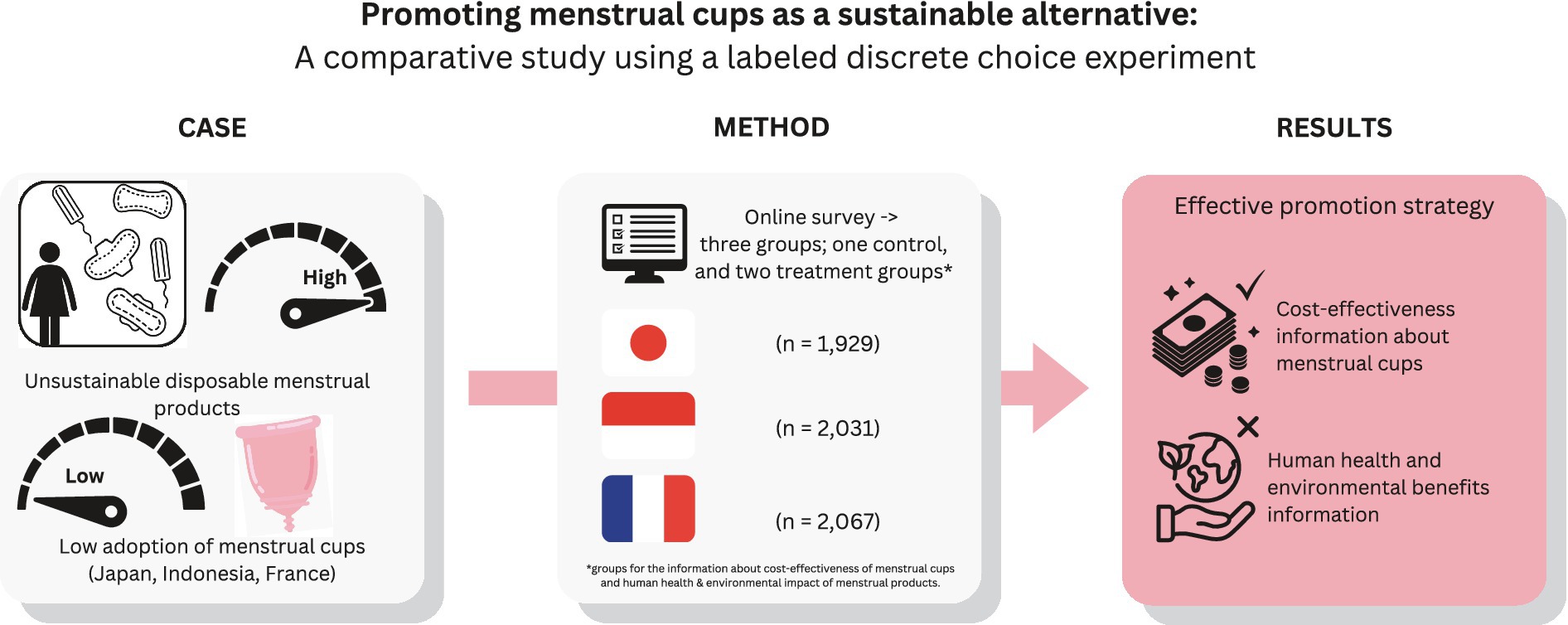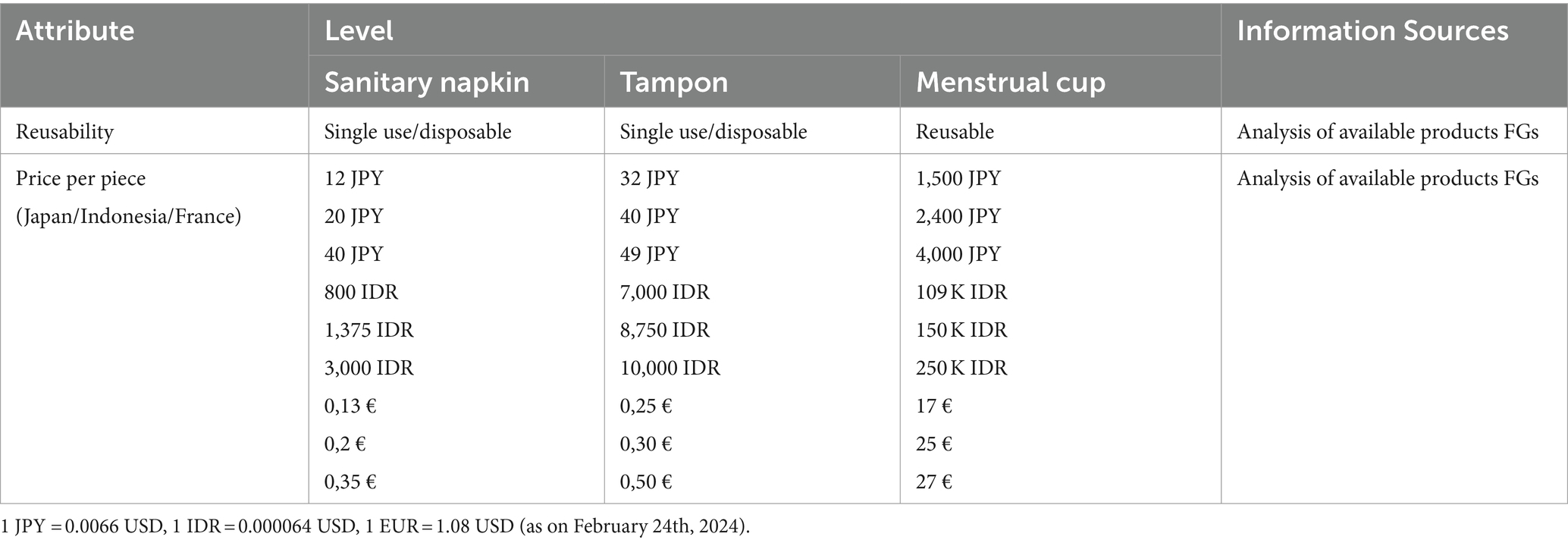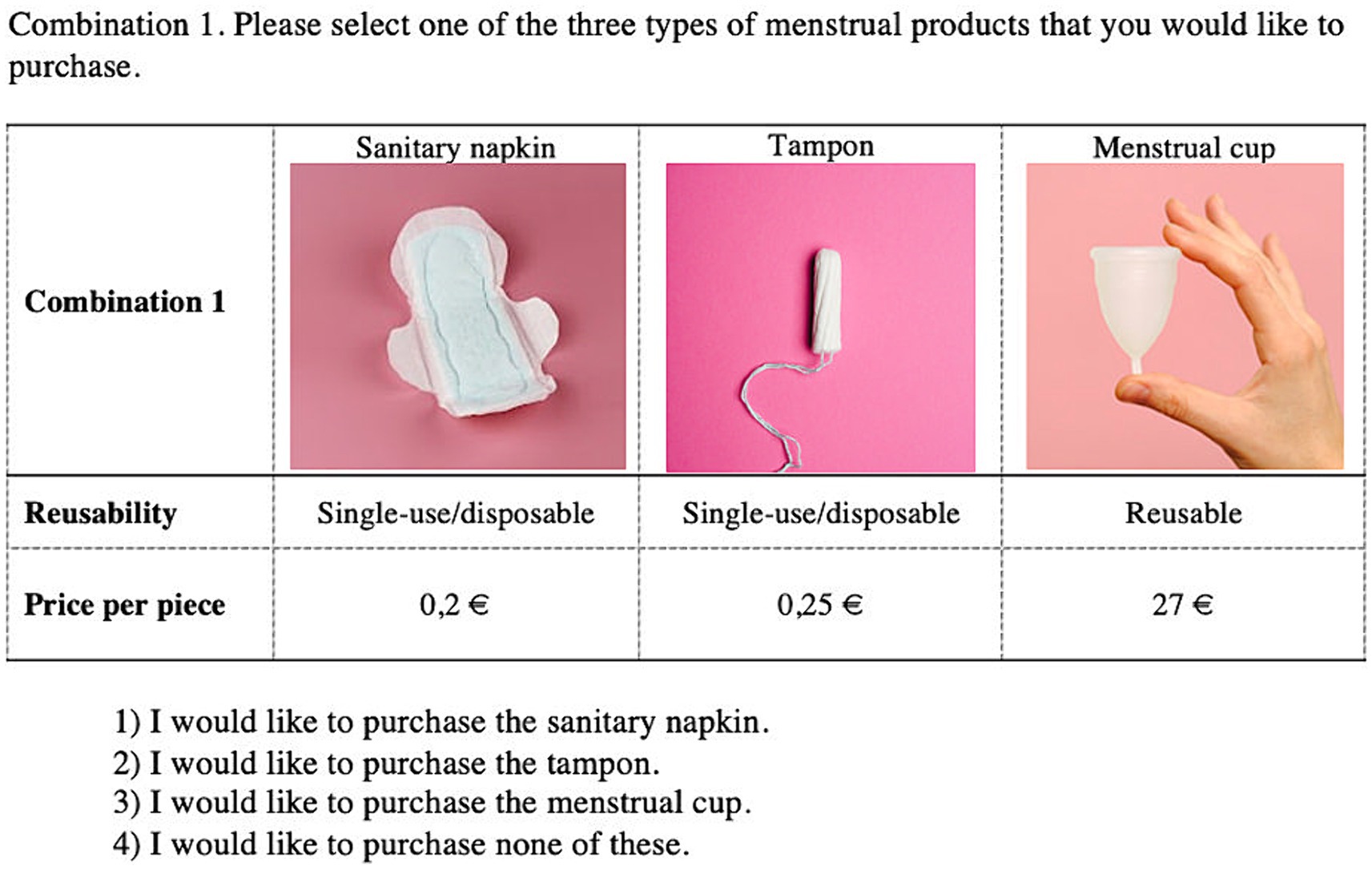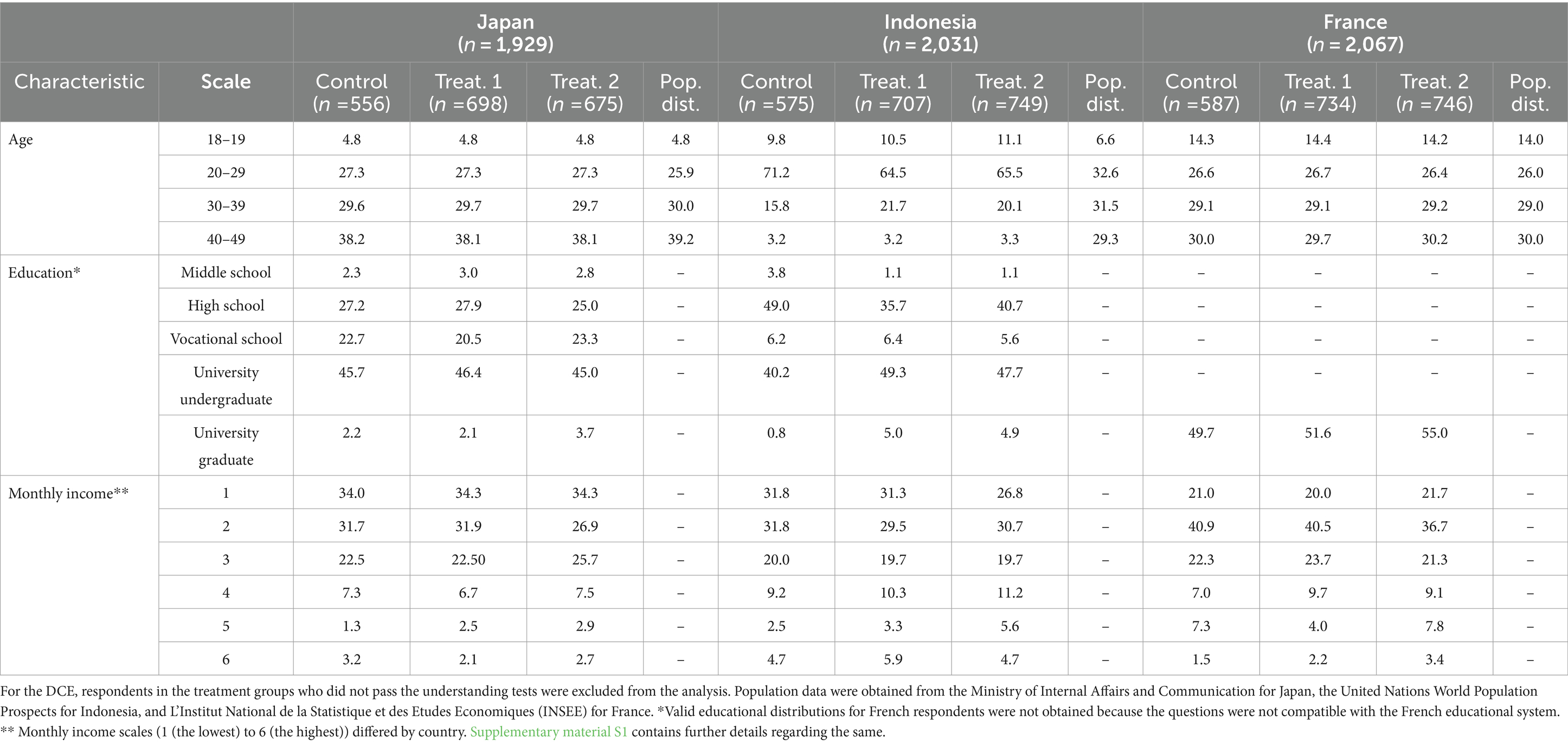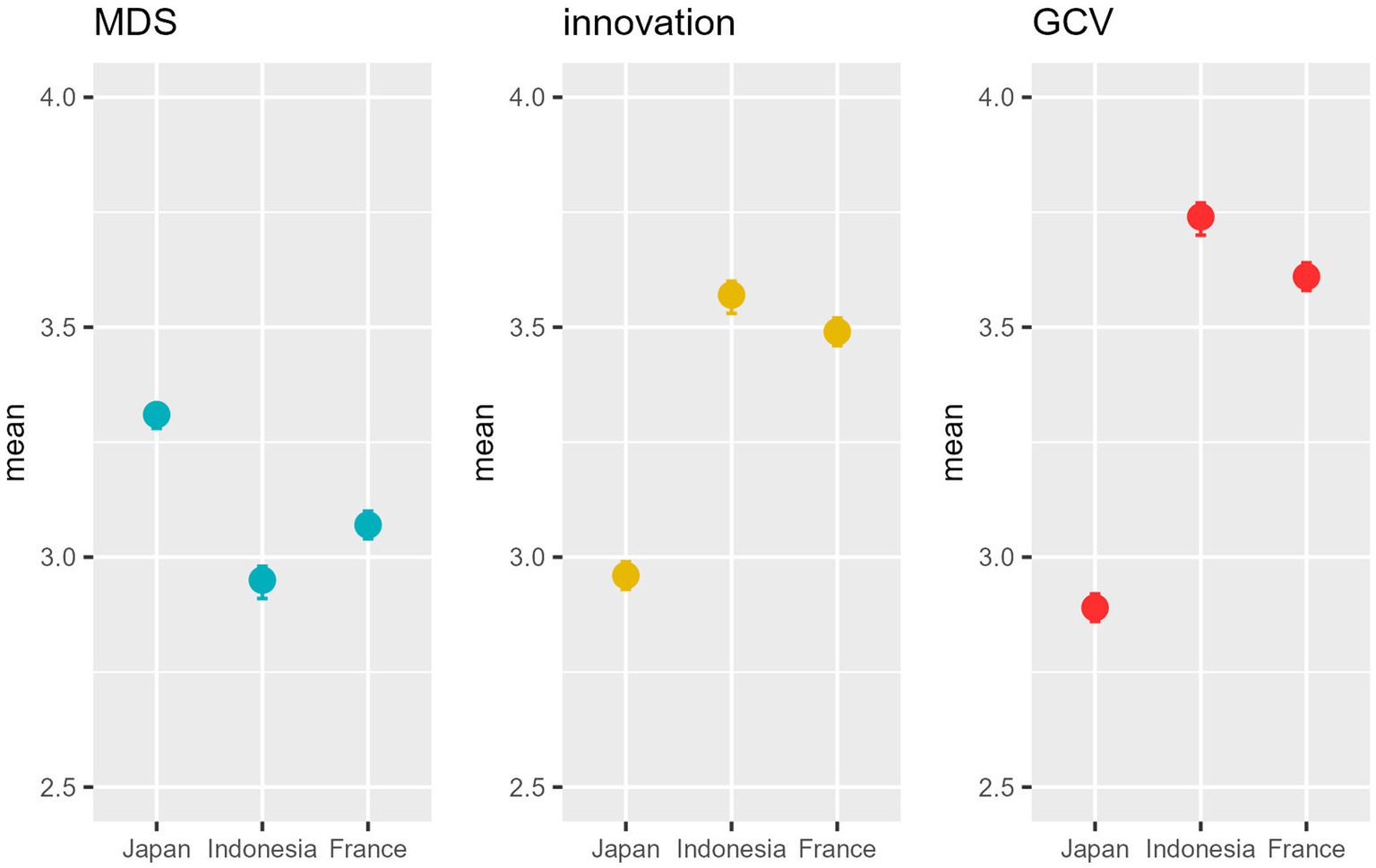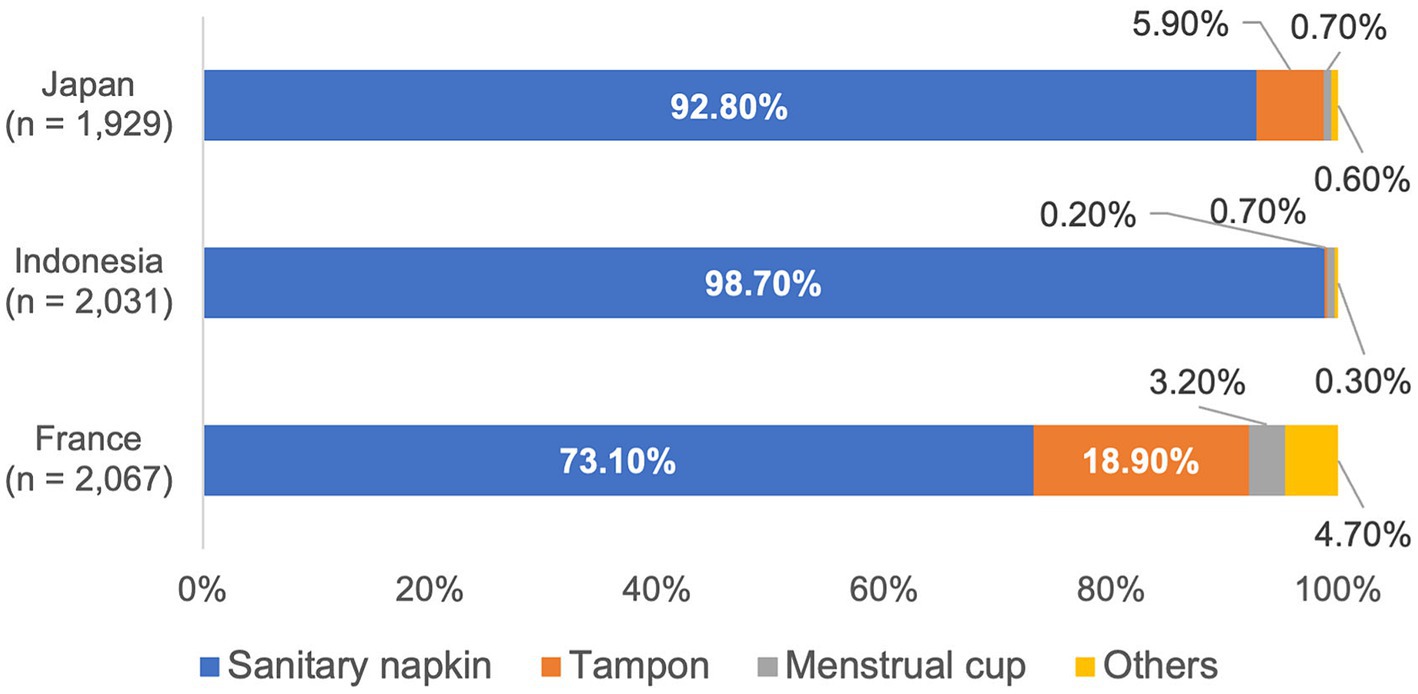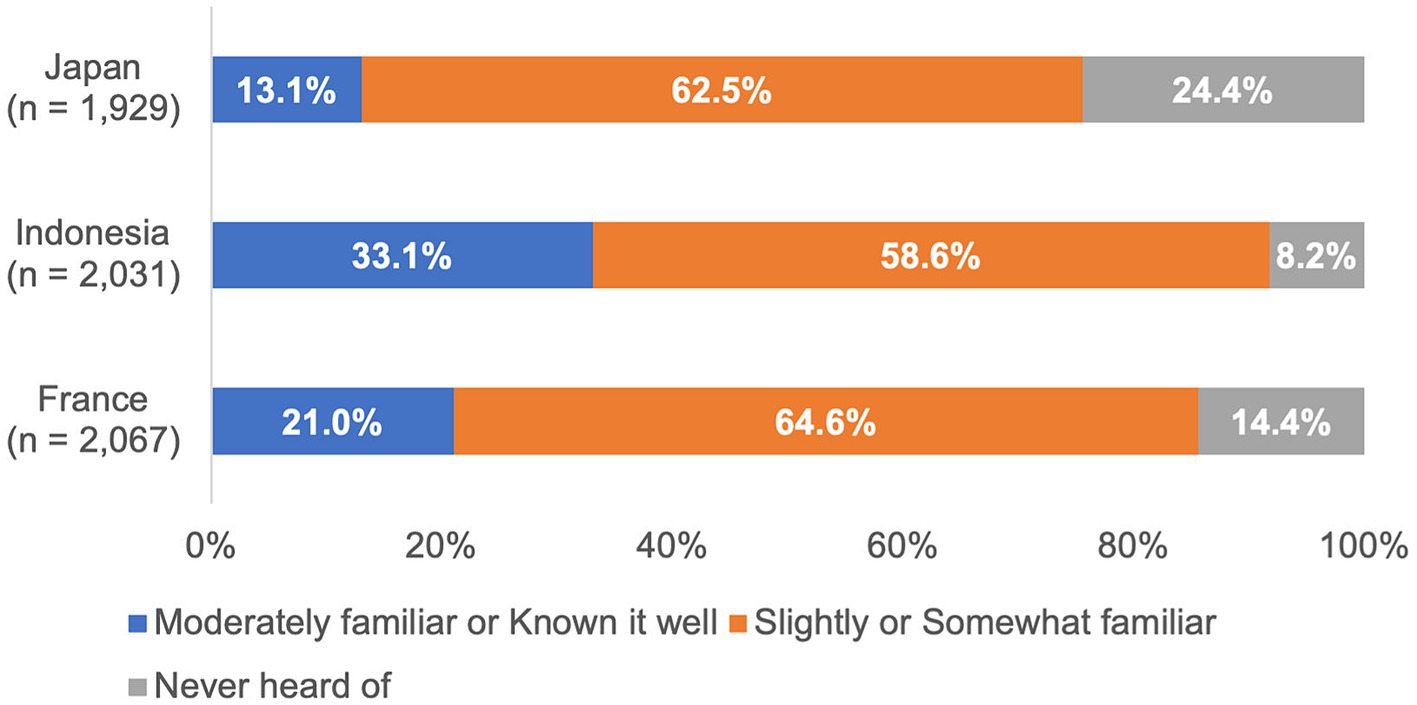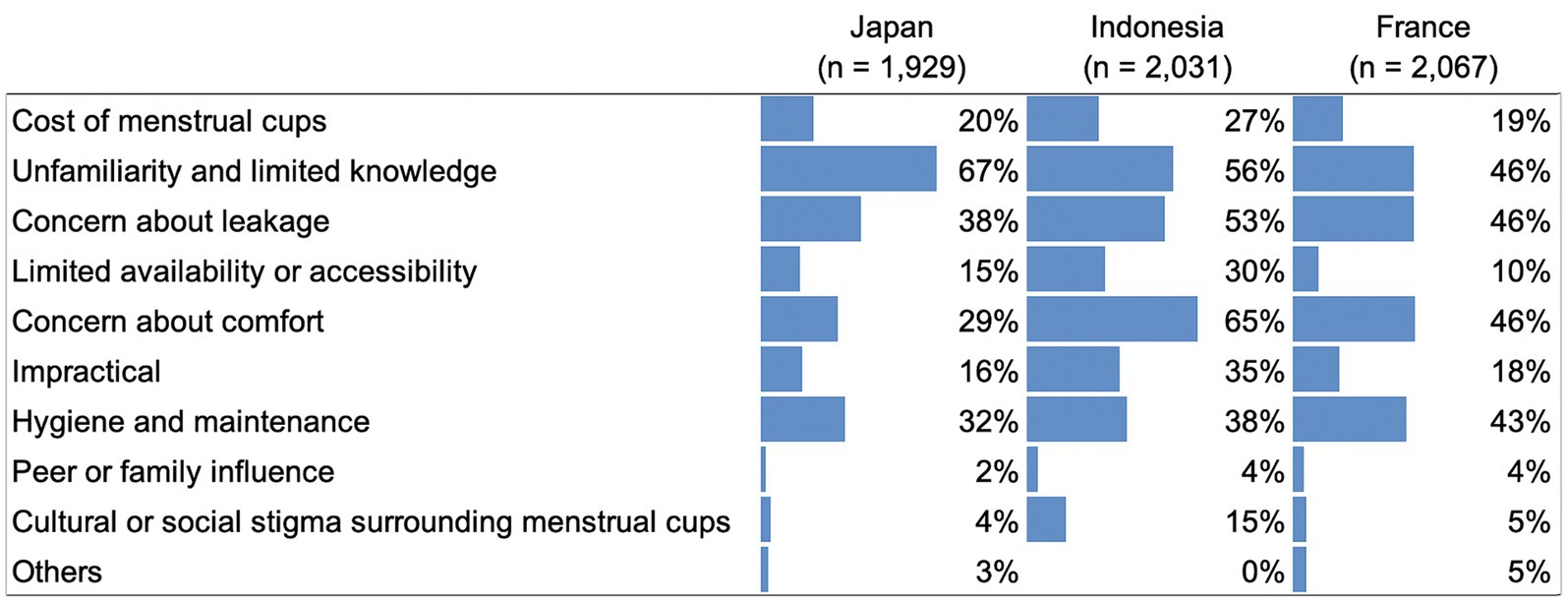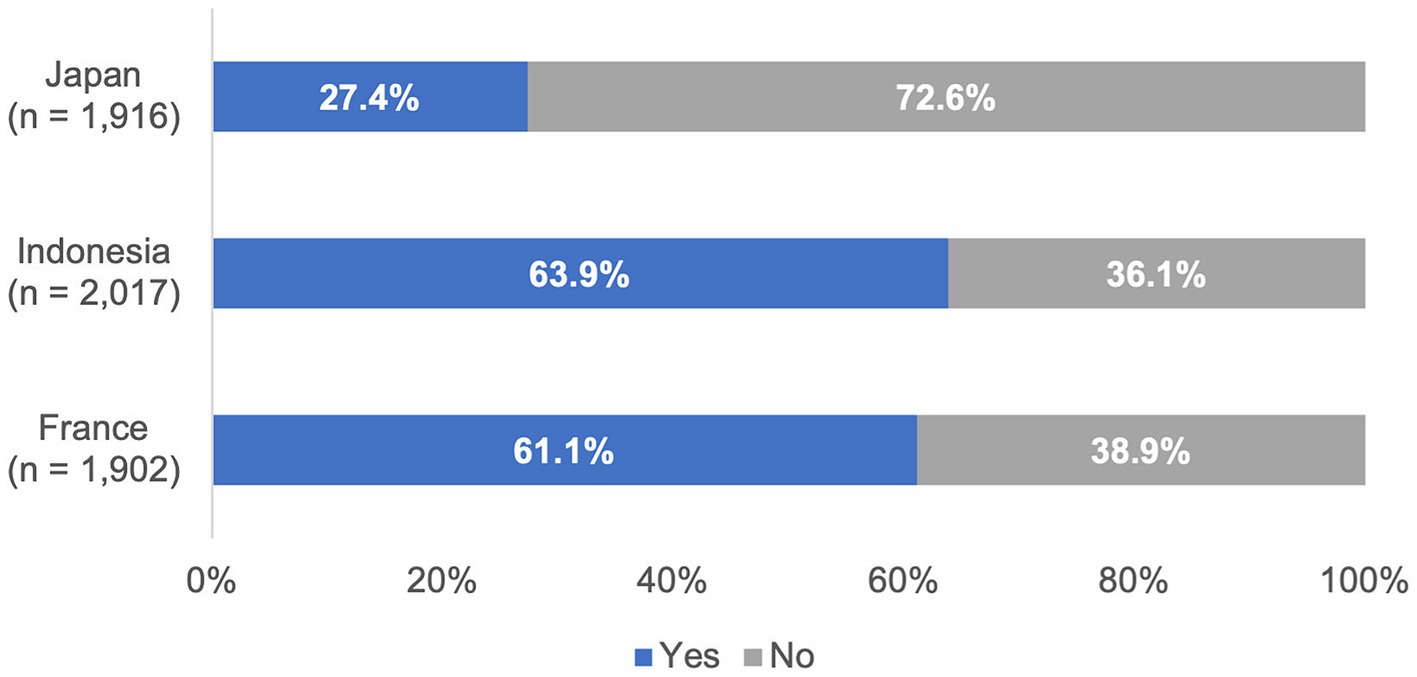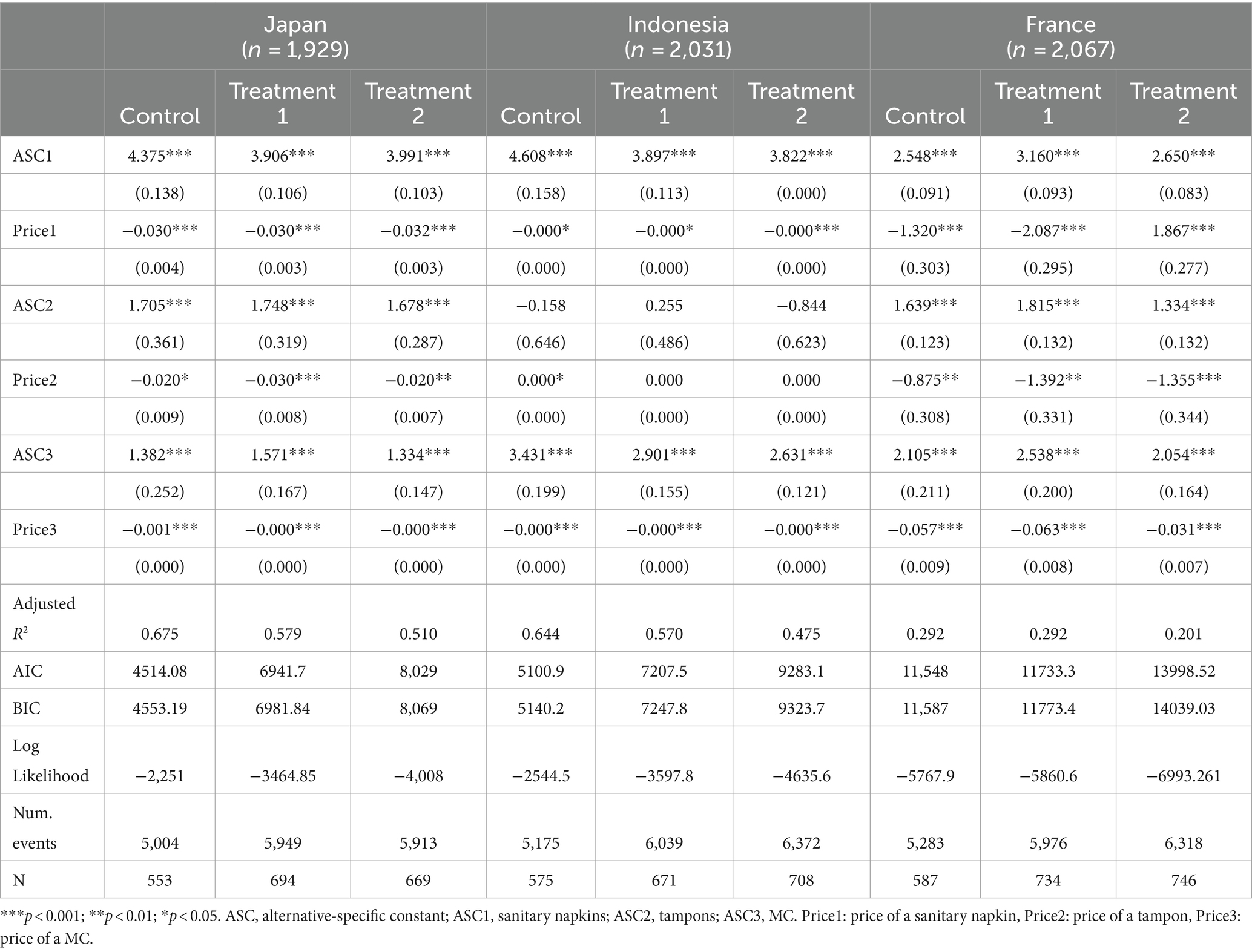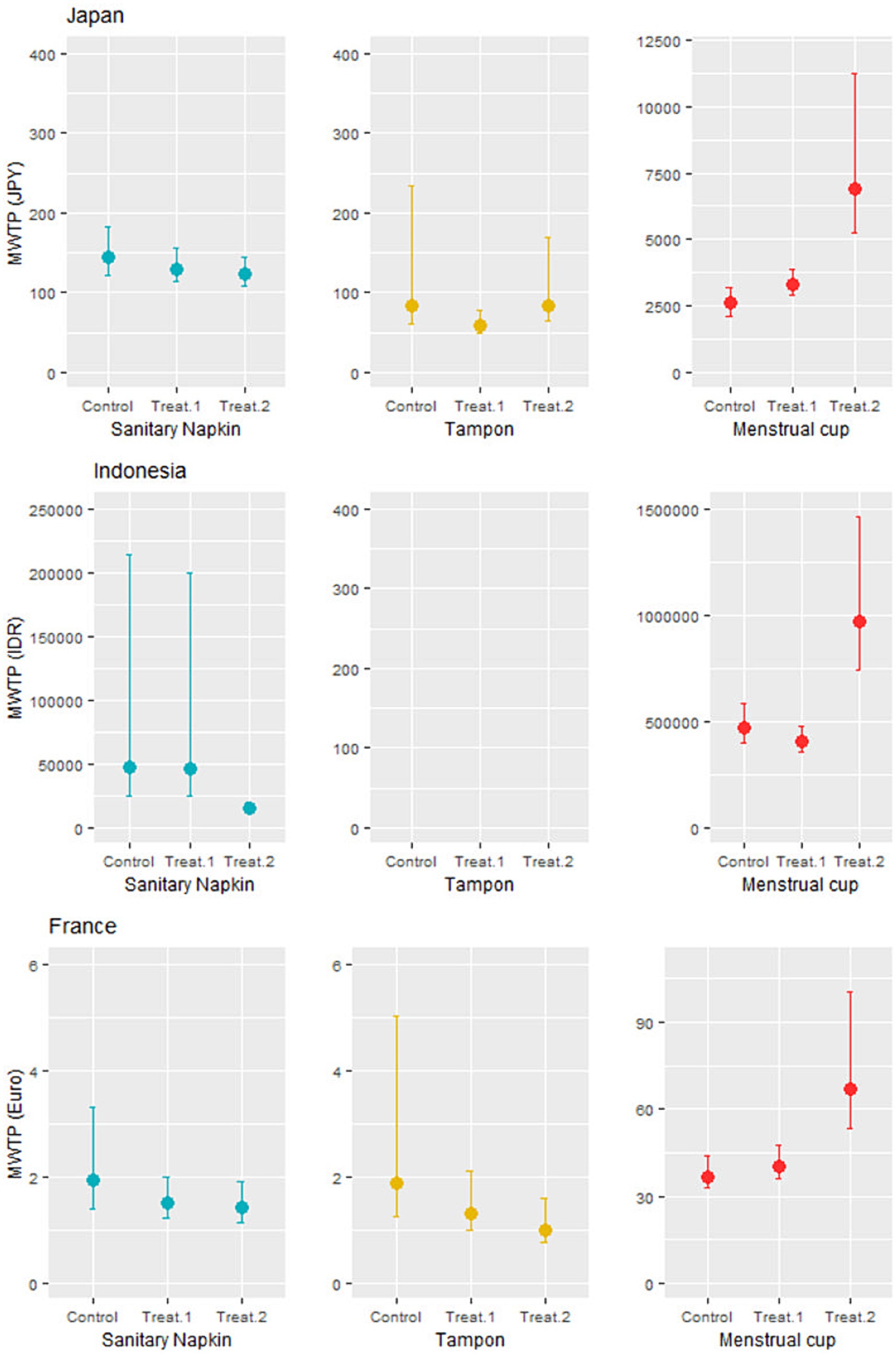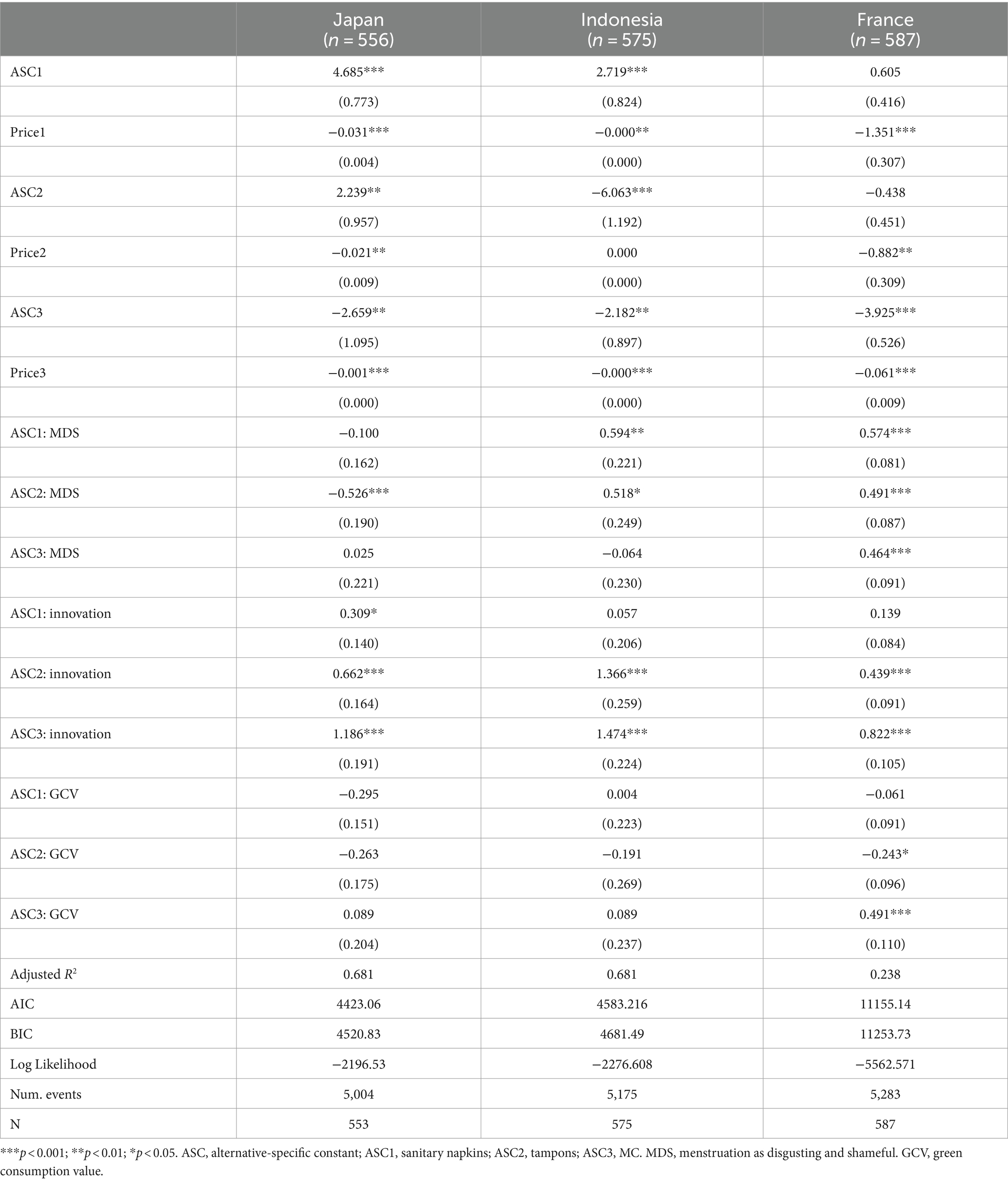- 1College of Policy Science, Ritsumeikan University, Ibaraki, Osaka, Japan
- 2Research Centre Cultures–Environnements–Arctique–Représentations–Climat (CEARC), Université de Versailles-Saint-Quentin-en-Yvelines, Université Paris-Saclay, Guyancourt, France
- 3Graduate School of Global Environmental Studies, Sophia University, Chiyoda, Tokyo, Japan
- 4Research Institute for Humanity and Nature, Kyoto, Japan
Plastic pollution is a global issue that endangers both human health and the ecosystem. Although interest in sustainable alternatives to single-use plastics has grown, their adoption has been insufficient, and menstrual products are no exception. Disposable menstrual products, such as sanitary napkins, continue to dominate over sustainable options like menstrual cups (MCs). Although studies on women’s perceptions and attitudes toward menstrual hygiene management have abounded, there is a lack of research on the development of promotional strategies for sustainable menstrual products. This study aims to fill this research gap by investigating consumers’ decision-making process in the face of a real-life option regarding menstruation products. In this comparative study, we conducted a labeled discrete choice experiment on consumers in Japan (n = 1,929), Indonesia (n = 2,031), and France (n = 2,067) to reveal their preferences for sanitary napkins, tampons, and MCs. The respondents from each country were divided into three groups (one control group and two treatment groups with information provided). The results showed that in all countries, the information regarding the cost-effectiveness of MCs (i.e., per-use cost) was unequivocally significant, whereas information about their health and environmental benefits was not. Access to free MCs can contribute to their adoption and alleviation of period poverty in all countries, with a relatively moderate acceptance in Japan. The results also showed variations across countries in consumer characteristics (attitude toward menstruation, innovation-friendliness, and green consumption) and the use and perceptions of MCs. Hence, tailored promotional strategies should be considered for each market.
1 Introduction
Despite being an essential component of daily life, the production and use of plastics are often inefficient and unsustainable (Notaro et al., 2022). Given the numerous negative effects of plastics on the environment, it is now widely acknowledged that plastic pollution poses a serious threat to the environment globally (OECD, 2022a). Tackling plastic pollution involves significant economic costs, or inaction to tackle pollution leads to environmental costs (Cordier et al., 2024). Geyer et al. (2017) estimated that between 1950 and 2015, cumulative waste generation of primary and secondary (recycled) plastic waste accounted for 6.3 billion tons globally, with 79% of the waste winding up in landfills or being scattered in the surroundings. Based on the model developed by Cordier et al. (2021, pp. 2–6) to update this value, the cumulative plastic waste over 1950–2022 was estimated to be 7.7 billion tons. Increasing trends in plastic use and waste are projected to continue (OECD, 2022b). Therefore, limiting plastic pollution has become a worldwide policy priority. The Group of Twenty (G20) adopted The G20 Implementation Framework for Actions on Marine Plastic Litter (MPL) to prevent additional plastic waste from entering the ocean (MoEFCC, 2023). Although most plastic waste is detrimental to the environment, single-use plastics continue to be a particularly challenging problem to tackle (Schnurr et al., 2018). Plastics Europe (2019) reported that 359 million tons of plastic were produced globally in 2018, of which single-use plastic products accounted for 50% of the total production (Plastic Oceans International, 2020; Chen et al., 2021). The European Union (EU) implemented a directive targeting single-use plastic products to reduce the quantity of waste generated and promote circular approaches (EU, 2019).
Reusable alternatives have attracted attention as they eliminate single-use plastics and combat the overuse of disposable plastics (Schnurr et al., 2018). However, among single-use plastics that harm the environment, menstrual products have received relatively scant attention despite their substantial consumption and impact on the environment (Peberdy et al., 2019). The EU directive listed single-use menstrual products (e.g., sanitary napkins and tampons) as one of the 10 targeted single-use plastic products (EU, 2019). Every month, hundreds of millions of women worldwide experience the natural biological process of menstruation, which typically lasts 5–7 days (Kuhlmann et al., 2017; Kaur et al., 2018). According to previous research, a woman uses an average of 10,000 sanitary napkins and 15,000 tampons on average during their lifetime (Bharadwaj and Patkar, 2004; Garg et al., 2011). Moreover, advertised menstrual products such as tampons or sanitary pads are estimated to take approximately 500–800 years to decompose, constituting a staggering burden on the environment (Sathishkumar et al., 2019; Peter and Abhitha, 2021; Babbar and Garikipati, 2023; Khorsand et al., 2023). In addition to ecological predicaments, each sanitary napkin emits 2–3.7 g of non-biodegradable plastic, and given the prevalence of plastic in these products, their complete biodegradation remains elusive (Ando et al., 2023; Kumari and Muneshwar, 2023).
In response to pressing environmental concerns posed by the extensive disposal of single-use menstrual products, menstrual cups (MCs) are being promoted to achieve sustainable menstruation (Peter and Abhitha, 2021; Alva and Gowda, 2023; Ahuja and Singh, 2023a). MCs are products made from flexible, medical-grade silicone designed to be folded and inserted into the vaginal canal. It serves the purpose of collecting menstrual fluid throughout a monthly cycle, using a specifically designed receptacle with a volume capacity of 10–38 milliliters (Beksinska et al., 2015; van Eijk et al., 2019). Studies have shown that MCs have the capacity to collect more blood than other disposable menstrual products, such as tampons or sanitary pads (Beksinska et al., 2015; Kakani and Bhatt, 2017; van Eijk et al., 2019). MCs are available in a variety of sizes and forms to accommodate different vaginal and cervical shapes (Mouhanna et al., 2023). It is recommended that MCs should be emptied at intervals of 4–12 h, depending on the menstrual cup model and flow (van Eijk et al., 2019; Peter and Abhitha, 2021). For cleaning, it is sufficient to wash the cup with water and a gentle cleanser during the cycle and to sterilize it by boiling it for 20 min before and after use at the beginning and end of the menstrual cycle (Kakani and Bhatt, 2017). Due to the differences in the frequency of changing, some studies have reported that the use of menstrual cups even saved water by reducing leakage and the need for frequent washing of clothes (Stewart et al., 2010; Peter and Abhitha, 2021). Based on life cycle assessment, MC is considered the most sustainable alternative to other disposable menstrual products due to the fact that the impact of an MC used for 1 year on health and environment is 1.5% that of other disposable menstrual products (tampons and sanitary napkins) and it costs only 10% as much while lasting up to 10 years (Hait and Powers, 2019; van Eijk et al., 2019). Additionally, compared to other reusable menstrual products like menstrual panties and pads, MCs consistently have the lowest environmental impact across all indicators, as the other reusable options require a substantially large amount of water. This assessment covers their entire life cycle, from manufacturing to disposal, thereby establishing MCs as the most eco-friendly option for menstrual flow management (Fourcassier et al., 2022). In addition to their environmental superiority, MCs have an additional benefit over disposable options – the absence of harmful compounds such as dioxins, which are commonly found in sanitary napkins and tampons (DeVito and Schecter, 2002; Khorsand et al., 2023). A recent systematic review has asserted that MC is a safe option for menstrual management (van Eijk et al., 2019). By adopting sustainable menstrual practices throughout the menstrual cycle, individuals can significantly reduce the accumulation of plastic waste in oceans and landfills, thereby benefiting both human well-being and the environment (Hait and Powers, 2019). This suggests that the MC is a sustainable and cost-effective menstrual product. With a smaller ecological footprint and the ability to be reused frequently, MCs have the longest lifespan among menstrual products, effectively reducing waste. By these means, the use of menstrual cups can significantly contribute to achieving the Sustainable Development Goals (SDGs) such as SDG 3 (Good Health and Well-Being), SDG 6 (Clean Water and Hygiene), SDG 12 (Responsible Consumption and Production), and SDG 13 (Climate Action).
Despite the human health and environmental benefits of MCs, their adoption is challenging. Women continue to believe that menstruation causes embarrassment (Khorsand et al., 2023). This is evidenced by the persistence of several menstruation taboos, such as the idea that women are impure, dirty, or sinful during menstruation (Little, 2011). These circumstances have created substantial barriers and difficulties for menstruation and the development of menstrual products. During their menstruation, most women use commercially available menstruation products such as sanitary napkins and tampons, especially with the advent of plastic applicators that attempt to ease product usage (Hait and Powers, 2019). Moreover, consumers presumably consider more factors than just the sustainability of a menstrual product when selecting one. Factors that are mostly connected to personal preferences, costs, and availability are also considered (Burt et al., 2016). According to Borowski (2011), the cost of a product is a vital factor for consumers, particularly those with low income. In addition to the environmental benefits that MCs provide, one of the highlights compared with other disposable menstrual products is their upfront cost (Khorsand et al., 2023). Additional factors include challenges related to their maintenance. Studies have indicated that in low- and middle-income countries, cleaning and storage of MCs pose significant obstacles to their adoption (APHRC, 2010; Hyttel et al., 2017). Furthermore, concerns have been raised regarding the practicality of emptying MCs in schools or public restrooms, which adds to the challenges associated with its use (Oster and Thornton, 2011). Additionally, it appears that people are still unaware of the environmental and health risks associated with disposable menstrual products. The decision to choose sustainable menstrual products such as MCs may involve navigating cultural norms and societal expectations, adding complexity to the consumers’ choice processes. Social norms and beliefs also hinder the widespread adoption of MCs, although accessibility may be a major factor leading to non-use (Stoilova et al., 2022; Valentin and Hechanova, 2023). According to research, non-users are reluctant to try MCs because they are afraid that it may break their hymen and lead them to losing their virginity, which contradicts social norms and jeopardizes various cultural values since women are traditionally expected to preserve their virginity until they are married (Pokhrel et al., 2021).
Although previous studies have identified factors that influence the selection of menstrual products, including a sustainable choice such as MCs, limited studies have examined how consumers incorporate these factors into their purchasing decision processes (Babbar and Garikipati, 2023). Listing barriers is insufficient to understand consumer decisions and develop effective promotional strategies for adopting MC. For instance, one study highlighted that social norms and perceived social costs may hinder the widespread adoption of MCs (Valentin and Hechanova, 2023). Thus, the decision to choose sustainable menstrual products such as MCs may involve navigating cultural norms and societal expectations, adding complexity to the consumer’s decision-making processes. However, the importance of these factors relative to other factors remains unclear. Because women compare different menstrual products, studies on how they compare them and choose MCs are required (van Eijk et al., 2019). Furthermore, because decision processes may differ in context, global studies comparing different contexts, such as developed and developing countries, are critical (van Eijk et al., 2019). A recent study in the Philippines indicated that despite a conservative culture, intentions to use MCs remain high, suggesting a potential balance between overall perceived benefits and societal norms (Valentin and Hechanova, 2023). In contrast, a study in India aimed to determine the knowledge, misconceptions, and acceptability of MCs revealed that many misconceptions regarding its use are still prevalent among potential users (Abraham et al., 2023). Subsequently, studies have investigated the impact of health perceptions on the attitude of women towards sustainable menstrual products (Ahuja and Singh, 2023a,b). Another study examined the relationship between sustainable menstrual product awareness and adoption (Ballal and Bhandary, 2020; Moon et al., 2020). This suggests that women express a desire to use these products, but lack of knowledge hinders their actual use. The current literature demonstrates a critical gap in understanding of the dynamics by which consumers incorporate diverse factors pertinent to sustainable menstrual products in their purchasing decisions. This lack of knowledge hinders the development of effective strategies to promote sustainable menstrual options and highlights the need for additional in-depth research in this area.
To address this research gap, this study aimed to investigate the stated preferences of consumers with varied characteristics in choosing menstrual products in different contexts to develop effective strategies that promote MC as a sustainable choice. To achieve this, we explored the following research questions by comparing consumers in Japan, Indonesia, and France to cover diverse contexts (Kuhlmann et al., 2017) and eliciting more general implications:
RQ1: What are the current uses and perceptions of menstrual products?
RQ2: How do information interventions influence consumers’ stated preferences for menstrual products?
RQ3: How do consumers’ characteristics affect their stated preferences for menstrual products?
RQ4: How can we promote the adoption of MC as a sustainable choice?
Online surveys were conducted to collect data to answer the research questions. A discrete choice experiment (DCE) was employed as a key analysis method (Aizaki et al., 2014), which elucidated consumers’ decision-making in choosing menstrual products among sanitary napkins, tampons, and MC. The respondents were women over 18 years old who were consumers of menstrual products in Japan, Indonesia, and France. Countries were chosen based on socioeconomic differences with the expectation that they could reveal similarities and differences, thereby providing generalized implications (Sesini et al., 2020). For each country, the respondents were split into three groups: a control group, treatment group 1 with information about the human health and environmental impact of menstrual products, and treatment group 2 with information about the cost-effectiveness of MC.
2 Materials and methods
We conducted online surveys on menstrual product consumers in Japan, Indonesia, and France. The respondents in each country were split into three groups using a treatment-control design to examine the impact of the information intervention (Grilli and Curtis, 2021). Therefore, a total of nine surveys were conducted.
2.1 Experimental design
A DCE and treatment-control design were employed to answer research questions 2, 3, and 4. DCE is a quantitative approach to assess the weight individuals assign to various factors when making decisions, which has risen to prominence as a common survey methodology for investigating a wide range of subjects, including marketing, environmental economics, and healthcare economics (Aizaki et al., 2014; de Bekker-Grob et al., 2019; Szinay et al., 2021; Lizin et al., 2022). Respondents are presented with choice sets containing multiple choices with varying levels of attributes and are asked to choose one of them or none if they do not find any choice attractive (i.e., opt-out option). DCE falls into two categories: unlabeled and labeled. In labeled DCE, options are named to enhance scenario authenticity and clarity, potentially yielding more accurate preference patterns and simplifying label-related effect analyses (de Bekker-Grob et al., 2010; Aizaki et al., 2014). We adopted a labeled DCE because it enables respondents to make choices based on easily identifiable attributes by their labels, making the choice task more realistic and less abstract, and ultimately enhancing the validity of results (de Bekker-Grob et al., 2010).
A treatment-control design reveals the impact of information intervention on consumer preferences by comparing treatment and control groups (Grilli and Curtis, 2021). This study prepared two treatment groups with human health and environmental information or cost-effectiveness information for different menstrual products. Information was provided before answering the DCE-related questions. To ensure their understanding of the information provided, respondents underwent comprehension tests. We excluded the respondents who failed to answer the test correctly twice in a row.
Prior to the surveys, three focus groups (FGs) were conducted to explore the decision factors underlying consumer preferences for menstrual products and verify the DCE design in the surveys (Blamey et al., 2000; Louviere et al., 2000); FG participants were asked about the relevance of the choice set, confirming whether the attributes reflected their interest in selecting menstrual products and assessing the realism of the levels. Moreover, the FGs aimed to explore a comprehensive understanding of the topic, including social norms and insights beyond the quantifiable data of the DCE study. Consumers of menstrual products aged 18–49 in Japan, Indonesia, and France were recruited through snowball sampling, a survey method that relies on referrals from the initially sampled respondents (Sedgwick, 2013; Johnson, 2014). On June 12th, 2023, eight participants were recruited for the Indonesian FG, eight were recruited for the French FG on June 16, 2023, and five were recruited for the French FG on July 9, 2023. A participant size of 5–10 was the recommended choice for preference studies (Louviere et al., 2000). In this study, a female researcher presided over all the FGs through an online meeting platform and recorded them. Informed consent was obtained from all participants. Prior to the FG, questionnaires were distributed as supplementary tools as an additional means for participants to express their thoughts, experiences, and opinions.
2.2 Questionnaire design
Three versions of the questionnaire were prepared for the three groups: one for the control group and two for the two treatment groups. They were translated into Japanese, Bahasa, and French and were finalized by the authors, whose first language was one of the three. Sample questionnaires in English have been provided in the Supplementary material S1.
2.2.1 Questionnaire structure
The three versions shared the same questions except that those for the treatment groups included an additional part for the information intervention. All questionnaires included a screening question for those who menstruated; sociodemographic characteristics; preferences and experiences with menstrual products; perceptions of menstrual products; DCE choice sets; intention to adopt MCs if they were free; and three psychological scales measuring perceptions related to menstruation as disgusting or shameful (MDS), innovation-friendliness, and green consumption value (GCV). Apart from DCE for analyzing consumers’ preferences for menstrual products, a question about intention to adopt free MCs was included to address “menstruation equity” and “period poverty” (Critchley et al., 2020) which can contribute to sustainable development goals 1 and 5 (United Nations, n.d.). The questionnaires for the treatment groups included information about human health, the environment, and cost-effectiveness.
2.2.2 Psychological scales
The MDS, innovation-friendliness scale, and GCV were measured using a five-point Likert scale ranging from 1 (strongly disagree) to 5 (strongly agree). While the items were drawn from the literature, some adjustments were made after the pre-test. The final version included seven items for the MDS and six items for innovation friendliness and GCV; all items are listed in SM1. The MDS was adopted to explore potential correlations between preferred menstrual products, social norms, and degree of social stigma using items obtained from Roberts (2004). Cultural and social factors can affect product preferences (Pokhrel et al., 2021; Ganz et al., 2022). The innovation-friendliness scale was used to investigate whether preferred menstrual products were associated with individuals’ willingness to switch to new, untried products; the scale was obtained from the innovation-friendly items of Scherer et al. (2017) and Klein et al. (2020). GCV measures the connection between preferred menstrual products and consumers’ environmental consciousness using items from Paço et al. (2019), as previous research suggests that environmentally conscious consumers lean towards sustainable options (Schwepker and Cornwell, 1991; Schuhwerk and Lefkoff-Hagius, 1995; Uehara et al., 2023a).
2.2.3 Labeled DCE design
The choice sets comprised three menstrual products, each characterized by two attributes, reusability and price, as shown in Table 1. This study selected sanitary napkins, tampons, and MCs as labels for two reasons. First, these products were widely utilized and popular among the target demographics, ensuring that the study’s findings were applicable to the intended population of the study. Sanitary napkins and tampons, which are acknowledged for their widespread use were selected (Ahuja and Singh, 2022). Simultaneously, we incorporated MCs, aligning it with the growing interest in sustainable alternatives, and recognized it as the most sustainable menstrual product (Peberdy et al., 2019; Peter and Abhitha, 2021). Second, product selection encompassed items used similarly across the three countries targeted in this study. This helps to ensure the comparisons and analyses made in the study are relevant and consistent across these different cultural and geographical contexts.
The reusability attribute had one level for all products based on the nature of the product: single-use/disposable or reusable. Meanwhile, price reflects the economic expenditure value, often referred to as sacrifice value (Borowski, 2011; Van Loo et al., 2020). Consequently, it was anticipated to exhibit an inverse relationship with consumer purchase intention, with higher prices indicating reduced purchase possibilities. These attributes act as terminal points that directly influence consumer utility functions (Boyd and Krupnick, 2009). The selection of these attributes and levels were determined through a market analysis of available products and were further validated through FGs. Participants in the FGs confirmed that these attributes and their respective levels accurately reflected their preferences when selecting menstrual product, ensuring the attributes were both relevant and reasonable.
The initial choice sets employed in DCE encompassed 27 distinct combinations. Nonetheless, by adopting an orthogonal main-effect design, a substantial reduction was achieved, resulting in nine combinations, obviating the need to partition respondents into separate blocks (Lorenzen and Anderson, 1993). The optimized composition of the choice sets was intended to enhance the efficacy and manageability of the decision-making process for respondents while preventing them from being overwhelmed by options (Aizaki et al., 2014). Figure 1 shows a sample of the DCE questions presented to the respondents.
Before the DCE questions, the treatment groups were provided with information about the human health and environmental impact of menstrual products (for Group 1) or the cost-effectiveness of MCs (for Group 2). We then tested their comprehension to ensure that they understood the information provided. The respondents in treatment group 1 were presented with a figure illustrating the relative human health and environmental impacts of menstrual products based on their life cycle assessments (Figure 2). Subsequently, the respondents were asked to assess their comprehension of the figure. Based on Figure 3, the participants were required to select the correct sequences from [1], [2], and [3]. If respondents failed to choose the correct answer, they were given the same information and retested. Those who failed the second round were subsequently omitted from the DCE analysis.
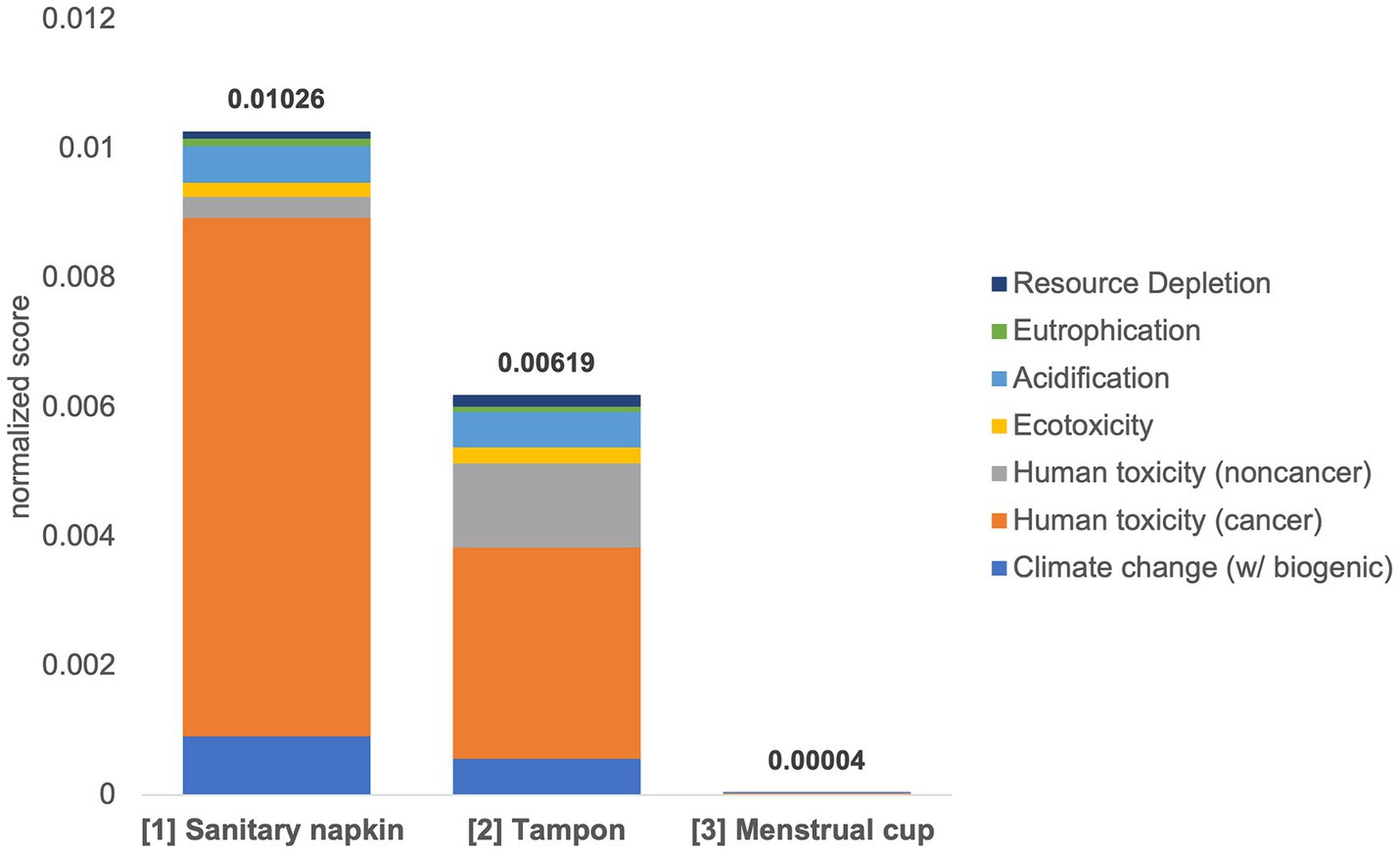
Figure 2. Human health and environmental information intervention for the treatment group. The figure was adopted and modified from Hait and Powers (2019).
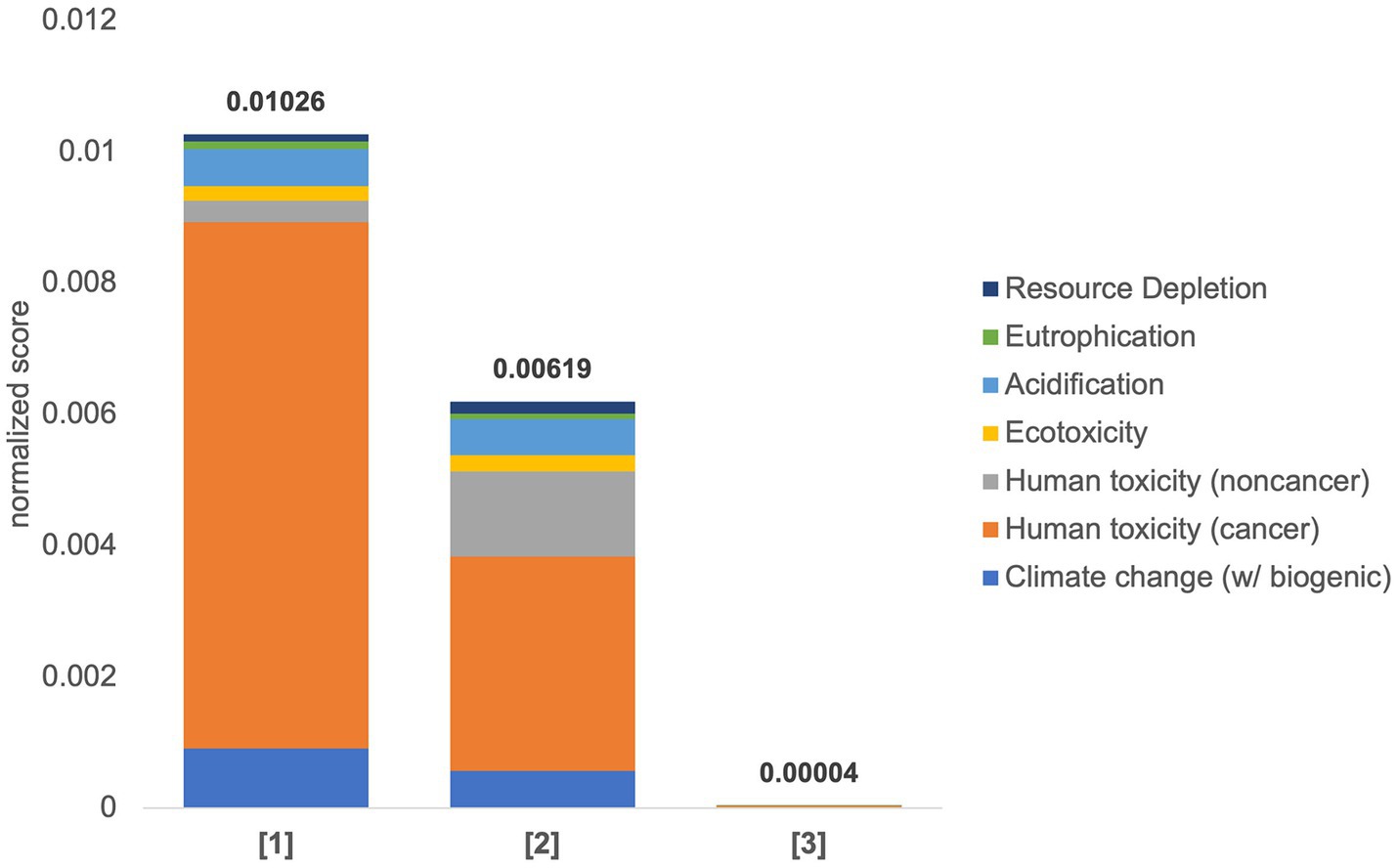
Figure 3. Illustration used to test the comprehension of the environmental impact of each menstrual product. The figure was adopted and modified from Hait and Powers (2019).
Information related to the cost-effectiveness of each menstrual product was provided to treatment group 2. A comprehensive description of this information is provided to ensure clarity and understanding (Table 2). Same as the first treatment group, respondents were asked to correctly sequence [1], [2], and [3] for sanitary napkin, tampon, and MC based on Table 3. Those who failed the second round were subsequently omitted from the DCE analysis.

Table 3. Illustration used to test the comprehension of process per use of each menstrual product for the treatment group 2.
2.2.4 Pre-test
Prior to the main survey, a pre-test involving 200 respondents was conducted on August 7, 2023. The pre-test aimed to evaluate the overall logic and comprehensiveness of the questionnaire. For instance, in the control group survey, the average usage duration of MC was initially presented as “5.25 years” to signify reusability. However, to provide a more realistic scenario, the average usage duration of MC was provided exclusively to the cost-effectiveness information treatment group during the main survey. The pre-test also led to refinements of the measurement scales. For example, one item was added to the MDS scale and two items within the innovation-friendliness scale were rephrased.
2.3 Data collection
We recruited 6,027 respondents aged 18–49 via survey companies (n = 1,929 from Japan; n = 2,031 from Indonesia; n = 2,067 from France). Individuals who failed to answer a trap question were removed during recruitment to maintain data quality (Liu and Wronski, 2018). The survey for the French group was conducted using Cint1 from September 20 to October 16, 2023; the survey for the Indonesian group was conducted using Populix2 from August 26 to August 30, 2023; and the survey for the Japanese group was conducted using iBRIDGE3 from August 17 to August 18, 2023. The questionnaire contained two eligibility requirements: (1) they must be 18–49 years old, and (2) they must be consumers of menstrual products in Japan, Indonesia, or France. For DCE analysis, respondents in the treatment groups who failed to correctly answer the comprehension assessment were removed, the passing rates were 90.5–97.3% (Supplementary Tables S1, S2). Informed consent was obtained from all respondents after explaining the purpose of the study and their rights. Data used in the study is available in the Supplementary material S2.
2.4 Data analysis
Under random utility theory, we applied a conditional logit model to analyze the data obtained from DCE (Aizaki et al., 2014). While the mixed logit model, which is a more flexible model, is being increasingly adopted (McFadden and Train, 2000; Hensher et al., 2015), we did not use it because our choice design did not include the attributes to be tested for heterogeneity. Price, the only attribute that varied across the choices in our design, was not specified as a random parameter. The systematic component of the utility for respondent n for alternative , (Equation 1), can be expressed as
where ASC is an alternative-specific constant, is the main effect associated with price, and the last three terms are two-way interaction terms between and covariates reflecting respondents’ psychological scales, and to are the interaction effects (Hensher et al., 2015). The systematic component of utility for the “none of these” option was set to zero.
Based on the conditional logit model estimates, we computed the marginal willingness to pay (MWTP), and the Krinsky and Robb method was employed to compute the 95% confidence interval of the MWTP (Aizaki et al., 2014). Data were analyzed using statistical software R, version 4.3.1 (The R Foundation, Vienna, Austria).
3 Results
3.1 Sample description
A total of 6,027 respondents were recruited (1,929 from Japan, 2,031 from Indonesia, and 2,067 from France). Table 4 presents the respondents’ sociodemographic characteristics. While the age distributions of the Japanese and French respondents were similar to those of the population, the Indonesian respondents’ age distribution was not because of the limitations of the sampling method, which might have affected sample representativeness.
Figure 4 depicts a comparison of the psychological scales, MDS, innovation friendliness, and GCV. Cronbach’s alphas for all scales, except the MDS for Japanese and Indonesian respondents, were above 0.70, indicating the reliability of the scales (Bland and Altman, 1997; Tavakol and Dennick, 2011). Since the 95% confidence intervals of MDS for the Japanese (0.66, 0.71) and Indonesian respondents (0.67, 0.71) were 0.70, we considered them acceptable. While the Japanese respondents had a higher mean MDS (3.31) than the Indonesian (2.95) and French respondents (3.07), they had a lower mean innovation (2.96) and GCV (2.89) than the Indonesian (3.57, innovation-friendliness, 3.74 for GCV) and French respondents (3.49 for innovation, 3.61 for GCV). While the values for the Indonesian and French respondents were similar to those of the Japanese respondents, they differed significantly for all three scales. Detailed information, including confidence intervals, has been mentioned in Supplementary Figure S1.
3.2 Current use and perceptions of menstrual products
Sanitary napkins are the most regularly used menstrual products in all countries, as shown in Figure 5. However, the reasons for this varied across countries (Supplementary Tables S4, S10, S16). While price and familiarity were common primary reasons for the respondents from all countries (>40%), functions (absorbency, leakage resistance, and comfort) were primary reasons (>40%) only for Indonesian and French respondents. Only the Indonesian respondents chose wide availability or accessibility (51%) as their primary reason. While the French respondents did not think convenience was the reason (19%), the Japanese and Indonesian respondents thought convenience was the primary reason (48 and 67%, respectively). Tampon use was the highest in France (18.9%) and the lowest in Indonesia (0.2%). The use of MC was limited in all countries but relatively higher in France than in the other two countries (3.2% of the French sample compared to 0.7% of the others). Comparing the reasons for choosing MC with those for the other two products, environmental consciousness was highly valued (38% for the Japanese, 86% for the Indonesian, and 52% for the French respondents). Similar to the reasons for using other products, price, leakage resistance, comfort, and convenience were also considered reasons. However, unlike with sanitary napkins, familiarity was not a reason for this finding. Additionally, a portion (4.7%) of French respondents used other menstrual products, such as menstrual panties and reusable towels.
Figure 6 illustrates respondents’ familiarity with MC. Most respondents knew what MCs are to some extent (75.6% of the Japanese respondents to 91.7% of the Indonesian respondents). Japanese respondents demonstrated relatively limited familiarity compared to the other two countries, with 13% indicating moderate or good familiarity. Indonesian respondents were relatively familiar with MC. French respondents fell between these two.
Figure 7 illustrates the perceived barriers to MC adoption. While “Unfamiliarity and limited knowledge” was the most significant barrier for the Japanese (67%) and French respondents (46%), “Concern about comfort” (65%) was the one for the Indonesian respondents. “Unfamiliarity and limited knowledge” (67%) relatively stood out for the Japanese respondents compared to other barriers. On the contrary, while “Unfamiliarity and limited knowledge” was also a concern for the French respondents (46%), it was less than those of the Japanese and Indonesian respondents and as equally critical as “Concern about leakage” (46%) and “Hygiene and maintenance” (43%). In addition to “Unfamiliarity and limited knowledge,” “Concern about leakage” and “Hygiene and maintenance” were common concerns in the three countries (>30%). The Indonesian respondents were concerned more about MC in most aspects than the Japanese and French respondents; notably, “Impractical” (35%), “Limited availability or accessibility” (30%), and “Cultural or social stigma surrounding MCs” (15%), were roughly more than double of those of the Japanese and French respondents.
Figure 8 illustrates the respondents’ willingness to adopt MC if it is free. Free MC is certainly an effective measure but is not equally effective across countries. Most Indonesian and French respondents expressed willingness to adopt free MC (63.9 and 61.1%, respectively), whereas Japanese respondents exhibited a lower level of willingness (27.4%).
3.3 Conditional logit model results
Table 5 presents the model estimates without the interaction terms. All coefficients of menstrual products across Japanese and French respondents were statistically significant. The price attribute consistently demonstrated a negative coefficient, indicating that an increase in price is associated with a decrease in the probability of choosing a product, aligning with the economic theory of consumer behavior (Louviere et al., 2000). However, the coefficients of tampons were not statistically significant for the Indonesian respondents, except for the price coefficient of the control group.
Figure 9 lists the MWTP values for menstrual products across the control and treatment groups by product type and country. The respondents in treatment group 2 (the group that received information on the cost-effectiveness of MC) in all countries showed a statistically significantly higher MWTP for MCs than the control and treatment group 1 (the group that received information on the impact of menstrual products on human health and the environment). Furthermore, no statistically significant difference was observed between the control and treatment group 1 regarding the MWTP for MCs. No statistically significant differences were observed in the MWTP for sanitary napkins and tampons across the groups of Japanese and French respondents. However, the MWTP for sanitary napkins for treatment group 2 of Indonesian respondents was significantly lower than that of the other two groups.
Table 6 presents the conditional logit model estimates with the interaction terms. The estimates are for control groups to focus on the influence of psychological factors (i.e., MDS, innovation friendliness, and GCV). The coefficient of the interaction term in the estimates (e.g., ASC1: MDS) explains how a psychological factor (MDS) affects the respondents’ MWTP for a menstrual product (sanitary napkins). While the Japanese respondents with high MDS preferred tampons less compared to the overall respondents, Indonesian and French respondents with high MDS preferred sanitary napkins and tampons, or all of them. Respondents with high innovation friendliness in all countries preferred tampons and MCs more than the overall respondents. Japanese respondents with high innovation friendliness also preferred sanitary napkins. The GCV demonstrated differences only in French respondents; French respondents with a high GCV preferred MCs more and tampons less than the French respondents overall.
4 Discussion
We investigated the current uses and perceptions of menstrual products (RQ1); the impacts of health, environment, and cost-effectiveness information on product preference (RQ2); the influence of consumer characteristics on preferences (RQ3); and strategies to encourage MC adoption in the target countries (RQ4).
4.1 Current use and perceptions of menstrual products (RQ1)
Sanitary napkins were the predominant choice across Japan (92.8%), Indonesia (98.7%), and France (73.1%, Figure 5). Our study revealed commonalities and differences in the reasons for choosing sanitary napkins across countries (Supplementary Tables S4, S10, S16). While Japanese respondents focused on prices, familiarity, and convenience, Indonesian and French respondents also cared about functions (absorbency, leakage resistance, and comfortability). This may mean that function is not a significant issue in the quality of menstrual products in the Japanese market or for Japanese consumers. For example, previous studies revealed that price is the main consideration for Japanese consumers (Tokunaka et al., 2018; Kigawa, 2023; Nakao et al., 2023). The availability of products was the primary reason for Indonesian respondents, implying a difference in the markets of Indonesia, Japan, and France. For example, the low use of tampons among Indonesian respondents can be directly attributed to the fact that tampons are mostly imported and less accessible, leading to a clear preference for sanitary napkins (Martin and Stuart, 2017; VanLeeuwen and Torondel, 2018).This aligns with the study by VanLeeuwen and Torondel (2018), who noted the high accessibility and affordability of sanitary napkins as pivotal factors in their widespread use. In France, while sanitary napkins were predominantly used, MCs were more widespread. These results coincide with those of a survey conducted in France (Petruzzi, 2022). Notably, environmental consciousness was highly valued compared to other products by the respondents, indicating that environmentally conscious consumers generally choose MCs. Therefore, the widespread use of MCs among French respondents may represent French consumer openness to environmentally friendly products (Fusaro, 2016; Trouillard and Dodman, 2020). The GCV was high for the French respondents. Although the GCV was also high for Indonesian respondents, there were other reasons for not choosing MCs, as discussed below. Price, leakage resistance, and comfort were also commonly chosen, indicating that consumers using MCs knew its cost-effectiveness and functions. Hence, lack of knowledge could be one of the primary reasons for not using MCs.
Overall, while regular MCs use was limited in all countries, the respondents were aware about MCs to some extent, highlighting a discrepancy between knowledge and actual use. However, some differences were observed. For example, despite the relatively high familiarity among Indonesian respondents, MCs usage was observed to be low. This aligns with the findings of Shelby and Puspitasari (2022) which suggests that familiarity alone does not ensure adoption, particularly in Indonesia. In Japan, the low knowledge level about MCs might be due to a lack of open dialogue about menstruation, as highlighted by Itaya et al. (2022). This absence of open dialogue hinders the understanding and acceptance of alternative menstrual products, potentially limiting informed choices and perpetuating reliance on conventional options (Peter and Abhitha, 2021).
Although the respondents in all countries were aware about MCs to some extent, “unfamiliarity and limited knowledge” remained relatively critical barriers to the adoption of MCs in all countries, indicating the importance of information strategies (Figure 7). In particular, “unfamiliarity and limited knowledge” stood out among others in the Japanese respondents. Singh et al. (2022) argued that non-acceptability issues stem from a deficiency in the awareness and understanding of menstrual products. Pokhrel et al. (2021) claimed that a detailed understanding of their use, upkeep, and associated hygiene practices may not be widespread. Moreover, Ahuja and Singh (2023b) have shown that adequate knowledge about sustainable menstrual products correlates with positive perception, thereby increasing their acceptability. This lack of detailed knowledge could explain why despite high awareness, the actual utilization of MCs remained relatively low. Additionally, “concerns regarding leakage” hindered adoption across all countries, with many women favoring the perceived reliability of sanitary napkins and tampons for leak prevention (van Eijk et al., 2019; Gharacheh et al., 2021).
In comparison, the Indonesian respondents raised more barriers in most aspects than the Japanese and French respondents, notably “Impractical” (35%), “Limited availability or accessibility” (30%), and “Cultural or social stigma surrounding MCs” (15%). This reluctance may stem from Indonesia’s conservative cultural context, where intravaginal insertion required by MCs challenges norms related to fertility and virginity (Harris, 2020; Pokhrel et al., 2021). Several studies in Indonesia have highlighted how religious and social norms can deter the adoption of MCs and similar products (Harris, 2020; Sato et al., 2021). As the world’s second-largest Muslim population, Indonesian sociocultural practices are significantly shaped by Islamic perspectives (Tempo.co, 2024). Within this community, virginity (often symbolized by an intact hymen) is esteemed as a marker of sexual purity and familial honor (Rashid and Michaud, 2000; Shalhoub-Kevorkian, 2005).
This has been observed in other developing countries such as India (Meenakshi, 2020). Although some studies claim the importance of stigma and shame in developed countries (Grose and Grabe, 2014), Japanese and French respondents did not show this tendency. Moreover, the limited availability of MC in Indonesia is a significant barrier to their adoption. Consumers prefer easily accessible and familiar menstrual products, often opting for affordable and practical disposable sanitary napkins (Philipp, 2022; Kamira and Rizkalla, 2023). Furthermore, the perception of “Impractical” indicates that a proportion of Indonesian respondents found MCs to be challenging to incorporate into their menstrual hygiene routines. This perception of impracticality may encompass various factors, including difficulties in use, inconvenience, compatibility with lifestyle, potential learning curve, and maintenance requirements, which align with the findings reported by Stewart et al. (2009). Further illustrating these practical challenges, participants in the FG expressed apprehension regarding the proper technique for washing and sterilizing the cups, particularly given the time investment necessary. Despite being aware of the environmental benefits, the trade-off between the perceived time or effort and the sustainability advantages did not favor the adoption of menstrual cups. These differences in perceived barriers highlight the need for tailored promotional strategies to encourage MC adoption in diverse cultural contexts.
4.2 Impact of information on consumers’ preferences for menstrual products (RQ2)
Across all countries, the MWTP for the treatment group with information about the cost-effectiveness of MCs was significantly higher than that of the control group; those for the treatment group with information on human health and the environmental impact of menstrual products were not statistically different from the control group (Figure 9). This suggests that cost-effectiveness is a compelling message for encouraging MC adoption, whereas health and environmental impacts are not as persuasive. This also implies that the cost-effectiveness of MCs is not perceived well. Consumers may focus on the upfront price per piece, which is shown in the price tag, rather than the long-term per-use cost, which is crucial when comparing MCs to disposable alternatives like sanitary napkins and tampons. The relatively low importance of the cost of MCs as a barrier seems contradictory (Figure 7). A recent French survey revealed that only 6.6% chose cost as the reason for not using MCs (Parent et al., 2022). However, this means that respondents had little sense of price in the first place. The insignificance of human health and environmental impacts was not expected, given that environmental awareness is a strong predictor of green purchases (Testa et al., 2020), and positive health perceptions favor sustainable menstrual products (Peberdy et al., 2019; Moon et al., 2020; Ahuja and Singh, 2023a). Gölbaşı Koç et al. (2023) also noted that knowledge of the environmental effects of single-use menstrual products might raise the demand for reusable options. In summary, given the inherent importance of pricing considerations for environmentally friendly and sustainable products, our results show that providing consumers with tangible data on the long-term cost-effectiveness of MCs can raise awareness and enhance the perceived value of these sustainable products.
While previous studies have indicated the economic advantages of MCs (Burt et al., 2016; Hyttel et al., 2017; Popović et al., 2019; Pokhrel et al., 2021; Khorsand et al., 2023), interestingly, prior studies of adopting sustainable menstrual products have often overlooked the cost-related aspect, focusing instead on other factors such as comfort, health risks, and psychological factors. For example, a systematic review and meta-analysis of MC uses identified barriers to adopting MC mostly about usability such as “Difficult to remove” and “Uncomfortable to wear” (van Eijk et al., 2019). Gharacheh et al. (2021) emphasized product functions and health risks, leaving economic analysis largely unexplored. Valentin and Hechanova (2023) investigated consumers’ intentions to use MCs by applying an extended theory of planned behavior. However, previous studies asserted that affordability is a decisive factor in the purchase of sustainable products (Martinho et al., 2015; Kushwah et al., 2019; Sultan et al., 2021). Consumers often undervalue the higher production costs of environmentally friendly products (Bissinger, 2019) while equating lower-priced goods with better value (Ghali and Toukabri, 2019). Providing cost-effectiveness information led to an observed increase in the MWTP for MCs, which is reasonable as respondents who were informed about the cost per use of menstrual products recognized that MCs represent a more economical choice over time than disposable menstrual products.
Notably, the MWTP for sanitary napkins in Indonesian respondents with cost-effectiveness information about MCs was significantly lower than that of the rest, those patterns were not observed in Japanese and French respondents. A possible explanation is that Indonesian consumers, potentially because of varying economic conditions, might exhibit greater price sensitivity, thus showing heightened responsiveness to information that underscores cost savings. Our study showed that the Indonesian respondents raised the prices as one of the primary reasons for adopting sanitary napkins (60%) and MCs (46%), as shown in the Supplementary Tables S21–S23 in SM1. Aligning with this observation, Boobalan and Nachimuthu (2020) highlight that consumer in developing economies tend to prioritize cost as a decision-making factor more than those in developed economies.
4.3 Psychological factors affecting consumers’ preferences for menstrual products (RQ3)
The Japanese respondents with high MDS preferred tampons less, indicating a reduced preference for tampons, possibly an indication of their inclination away from menstrual products that require internal use. MC requiring internal use was not significant, probably because they did not know about it in the first place. In contrast, Indonesian respondents with high MDS preferred tampons and sanitary napkins. More knowledge, particularly concerning to MCs (Figure 7), could explain their relative preference for MCs. Interestingly, French respondents with high MDS scores preferred all available options. A possible explanation is that they preferred to choose these three products rather than buying nothing (i.e., opt-out option) to better manage menstruation. Notably, the MCs might be preferred by the respondents with high MDS because of their perception of lower health risks posed by them (Parent et al., 2022); 66% of the survey respondents chose “Less harmful/dangerous to health” as a reason for using MCs. The French FG in our study also showed sensitivity to health risks.
Respondents with high innovation friendliness in all countries preferred tampons and MCs over sanitary napkins. Because people with high innovation friendliness are more receptive to experimenting with and adopting novel products, this inclination can be attributed to their attraction to the novelty and unfamiliar nature of these menstrual products. Notably, despite their high innovation friendliness, Japanese respondents also showed a significant preference for sanitary napkins, potentially due to their high ‘Uncertainty Avoidance’ (Hofstede Insights, 2019) and extensive marketing innovations within this product, dampening their incentive to explore unfamiliar products. Although no objective data were available, we observed various TV commercials appealing to their innovative menstrual products.
We observed a significant relationship between GCV and menstrual product choice among French respondents, with those exhibiting a high GCV showing a pronounced preference for MCs and a negative preference for tampons. The lack of knowledge and experience in MCs among Japanese and Indonesian respondents with high GCV (Figures 5, 6) could explain why people with high GCV did not show distinctive preferences for MCs. They did not know much about their environmental benefits. More French respondents used MCs regularly (Figure 5).
4.4 Implications for promoting MC (RQ4)
Disseminating cost-effective information is a promising measure for promoting sustainable menstrual products for any type of consumer in any country, given that it was significant across all three countries in our study. It can be disseminated through various paths such as health professionals, information campaigns, companies, and media (Parent et al., 2022). Installing informational displays adjacent to MCs may be very effective; hence, at the point of purchase, the strategy is called simplification and framing, one of the nudges that can change people’s behavior without overt coercion (Uehara et al., 2023b). Because the target is price, adding per-use cost information to the price tag can be both convenient and effective. A recent study adding the true costs comprising negative social and environmental costs of a product demonstrated its effectiveness as a nudge (Wilken et al., 2024). In countries such as Japan and France, where digital price tags, including per-unit costs, are common, the additional cost of the strategy may not be prohibitive. Conversely, in countries like Indonesia, where digital price tags are less common, manual pop-ups can be used by stores.
While some strategies can be applied to most countries (e.g., cost-effectiveness information), it is also important to tailor strategies reflecting the differences in consumers and markets in each country, as our study showed variations in consumer characteristics and preferences across the three countries. For example, strategies to enhance awareness and provide comprehensive knowledge about their benefits are particularly important for Japanese consumers, as the knowledge and experience of MCs are limited among Japanese respondents. Influencer marketing, which is anticipated to reach an expenditure of 74.1 billion JPY by 2023, offers a promising platform for educational initiatives (Statista, 2023). Influencers and key opinion leaders (KOLs) can effectively promote sustainable consumption (Tran and Uehara, 2023). Since psychological hesitation and apprehension about the initial use of MCs are key among Japanese consumers, as found in our study, which is also in line with a previous study (Itaya et al., 2022), KOLs can play a critical role in demystifying MCs and addressing common concerns through trusted endorsements. In line with this, recent studies have shown that education and mass media exposure significantly increase the likelihood of adopting menstrual cups (Babbar and Garikipati, 2023; Balkan and Koyucu, 2024). Furthermore, educating about menstrual cups aligns with Sustainable Development Goal (SDG) 5 by reducing the stigma around menstruation and fostering a more inclusive and equal society. Although such promotional strategies are equally important in Indonesia, it is essential to synchronize MC marketing with improvements in distribution, owing to the significant role of product availability and accessibility in shaping consumer choices. Strategic partnerships with Indonesian retail entities could extend MC’s reach while supporting the government’s initiative to fortify micro, small, and medium enterprises (MSMEs) through the promotion of locally produced MCs, thus enhancing both access and affordability (Coordinator of the Ministry of Economic Affairs of the Republic of Indonesia, 2022). Furthermore, integrating culturally tailored campaigns such as myth-busting initiatives and ensuring halal certification resonates with Indonesia’s socio-religious context, thereby enhancing the likelihood of widespread adoption (Septiani and Ridlwan, 2020). In the French market, comfort is highly valued, with a significant proportion of respondents (56%) ranking comfort as the primary factor in choosing menstrual products, whereas 46% cited comfort concerns as a barrier in adopting MCs. Hence, MCs marketing should highlight its ease of use and adaptability to active lifestyles. Moreover, detailed and clear communication about a product’s environmental benefits and waste reduction is essential to address the preferences for reliable information, as identified by Herbes et al. (2020). Additionally, assurances of quality and safety, supported by medical endorsements and third-party reviews, are vital to meet the health-oriented expectations of French consumers, who often depend on healthcare professional guidance when selecting menstrual products as raised in the French FG; a study also revealed that 91.2% of the respondents chose health professionals as desired sources of information on menstrual products (Parent et al., 2022).
The provision of free MCs is a promising approach. Although the respondents’ use of MCs ranged from 0.70 to 3.2%, the willingness to adopt free MCs among the respondents who did not regularly use them ranged from 27.4 to 63.9%. In addition to its effectiveness in promoting a sustainable solution, free provisioning could enhance menstrual health management, which eventually address period poverty globally. While period poverty has often been discussed in low- and middle-income countries (Critchley et al., 2020; Rossouw and Ross, 2021), developed countries are no exception. A survey with Japanese young women found that 35.9% of them had been hesitant to or were unable to buy menstrual products for economic reasons (Plan International Japan, 2021). A survey with Japanese junior and high school male and female students revealed that 40.6% of them knew or had heard of period poverty (Nishinomiya City Center for Gender Equality, 2021). As of 2022, the Japanese government and municipalities have initiated programs, such as providing free sanitary napkins (Gender Equality Bureau Cabinet Office, 2022). Similarly, in France, 30% of young women aged between 18 and 24 struggle to afford menstrual products (Nilsson-Julien, 2023). In response, the French government made reusable menstrual products free for people under 26 years of age (Service Public.fr, 2023). Although the Japanese respondents’ willingness was lower (27.4%), the adoption of reusable menstrual products, such as MCs, can be improved through their understanding and experience. They had limited knowledge compared with Indonesian and French consumers, which was a barrier to adoption (Figures 6, 7). Their impression of them also included limited knowledge and being afraid of using them (e.g., “I am worried because I have never used it before,” “Afraid”). Governments, including those in developed countries, have taken the initiative to provide free-period products to their citizens (Rodriguez, 2021). For instance, Scotland became the first country to offer free menstrual products to all students in schools, colleges, and universities, as part of its commitment to eradicate poverty. However, the predominant focus on disposable items, apart from a few exceptions such as France, highlights the urgent need to pivot towards sustainable alternatives. This not only provides a long-term solution for period poverty but also contributes to environmental sustainability. Although most initiatives have targeted certain populations, such as youth and college students, they offer good opportunities to learn and experience using MCs. Hence, this exposure could cultivate a preference for MCs among individuals once they transition to purchasing their menstrual products. Conversely, free distribution of MCs, although well-intended, might inadvertently restrict choice by presenting MCs as the sole viable option for individuals facing financial difficulties. This could potentially create a dynamic where economic necessity, rather than personal preference, dictates the uptake of menstrual products, questioning the ethics of choice and reinforcing existing social hierarchies. To truly address period poverty, these initiatives must ensure that the introduction of free MCs is accompanied by educational efforts to inform users about their benefits and maintenance requirements, highlighting the importance of personal choice and minimizing any potential stigma associated with their use (Michael et al., 2020; Schmitt et al., 2022; James et al., 2024).
5 Conclusion
The use and perceptions of MCs are limited in all countries, indicating the potential impact of information and experience with menstrual products on their promotion. The treatment-control design using a DCE revealed that in all countries, cost-effectiveness information about MCs was unequivocally key to promoting it, compared to human health and environmental information about menstrual products. While the former was expected, as price is key to purchasing decisions, the latter was not, as researchers have often focused on promoting pro-environmental behavior, including purchasing sustainable products. The variations among consumers in all three countries suggest that promotional strategies must be tailored for each market. For example, although price was a common concern, there were differences in the critical barriers to MCs adoption among the three countries. Their characteristics in terms of psychological factors (i.e., menstruation as disgusting or shameful [MDS], innovation-friendliness, and green consumption value [GCV]) and their impact on choosing menstrual products also varied. Finally, the strong willingness to adopt free MCs in all three countries indicates its global effectiveness. This will contribute to a sustainable society, not only by adopting sustainable MCs instead of disposable products, but also by alleviating period poverty.
Five limitations of our study should be noted to devise more comprehensive promotion strategies for adopting sustainable menstrual products. First, our findings were derived from a survey using the stated-preference method, which may not align with actual consumer actions; this can be corroborated by the implementation of a field experiment or the integration of psychological theories that explain consumer behavior, thereby enhancing the reliability and applicability of our findings. Second, more studies on the impact of free MCs are needed as our study underscores its potential effectiveness. While our research hints at the potential effectiveness of providing free MCs, further investigation is required to explore practical distribution methods and assess economic viability through cost–benefit analyses. Third, our study did not fully investigate the impact of information interventions on correcting the lack or misunderstanding of MCs. This can have a significant impact on the adoption of MCs, given consumers’ limited knowledge and experience. Fourth, the comparability of our cross-country survey results might be influenced by differences in demographic, cultural, and socioeconomic circumstances across the sample populations. Efforts to standardize survey methods were made, however inherent variances may potentially impact comparability. Finally, this study focuses on MCs as a sustainable alternative. However, given that the intravaginal insertion required by MCs is a challenge for some women and other sustainable alternatives such as menstrual panties and reusable towels were adopted among French respondents, these alternatives should also be considered.
Data availability statement
The original contributions presented in the study are included in the article/Supplementary material, further inquiries can be directed to the corresponding author.
Ethics statement
Ethical approval was not required for the studies involving humans because Ethical approval by the research ethics review committee is not mandatory at my university and our research is exempt from review by the committee (https://www.ritsumei.ac.jp/research/approach/ethics/mankind/). The data were analyzed anonymously. The studies were conducted in accordance with the local legislation and institutional requirements. The participants provided their written informed consent to participate in this study.
Author contributions
SP: Writing – review & editing, Writing – original draft, Visualization, Software, Resources, Methodology, Investigation, Formal analysis, Data curation, Conceptualization. TU: Writing – review & editing, Visualization, Supervision, Resources, Project administration, Investigation, Funding acquisition, Data curation. MC: Writing – review & editing, Resources, Investigation. TT: Writing – review & editing, Validation, Methodology. MA: Writing – review & editing, Supervision, Funding acquisition.
Funding
The author(s) declare that financial support was received for the research, authorship, and/or publication of this article. This research was funded by the Environment Research and Technology Development Fund of the Environmental Restoration and Conservation Agency of Japan [grant number JPMEERF21S11920].
Conflict of interest
The authors declare that the research was conducted in the absence of any commercial or financial relationships that could be construed as a potential conflict of interest.
Publisher’s note
All claims expressed in this article are solely those of the authors and do not necessarily represent those of their affiliated organizations, or those of the publisher, the editors and the reviewers. Any product that may be evaluated in this article, or claim that may be made by its manufacturer, is not guaranteed or endorsed by the publisher.
Supplementary material
The Supplementary material for this article can be found online at: https://www.frontiersin.org/articles/10.3389/frsus.2024.1391491/full#supplementary-material
Footnotes
References
Abraham, R., Rajan, M. P., John, S., and John, A. (2023). Knowledge, acceptability and misconceptions regarding menstrual cup among college students of Kerala: a cross-sectional study. Indian J. Public Health Res. Dev. 14, 399–406. doi: 10.37506/ijphrd.v14i2.19139
Ahuja, P., and Singh, N. (2022). Sustainable menstrual products: the challenges ahead. Asian J. Wom. Stud. 28, 397–411. doi: 10.1080/12259276.2022.2098896
Ahuja, P., and Singh, N. (2023a). Comprehending women beliefs towards sustainable menstrual products – a fundamental step in healthcare. Int. J. Human Rights Healthc. doi: 10.1108/ijhrh-08-2023-0068
Ahuja, P., and Singh, N. (2023b). Redirecting to sustainable menstrual products – a holistic approach for improving public health. Int. J. Human Rights Healthc. doi: 10.1108/ijhrh-09-2023-0076
Aizaki, H., Nakatani, T., and Sato, K. (2014). Stated preference methods using R. Boca Raton, FL: Chapman and Hall/CRC.
Alva, P., and Gowda, S. (2023). Transformative impact of menstrual cup: a game changer. J. South Asian Fed. Obstet. Gynecol. 15, 754–756. doi: 10.5005/jp-journals-10006-2320
Ando, Y., Yokoi, H., Masuda, H., and Asari, M. (2023). Product-based approach to sustainable plastic management focusing on consumers’ necessity of 50 daily-use products in Japan. J. Clean. Prod. 418:138234. doi: 10.1016/j.jclepro.2023.138234
APHRC (2010). Use of menstrual cup by adolescent girls and women: Potential benefits and key challenges. Nairobi, Kenya: The African Population and Health Research Center (APHRC).
Babbar, K., and Garikipati, S. (2023). What socio-demographic factors support disposable vs. sustainable menstrual choices? Evidence from India’s National Family Health Survey-5. PLoS One 18:e0290350. doi: 10.1371/journal.pone.0290350
Balkan, E., and Koyucu, R. G. (2024). The menstrual cup knowledge, attitudes, and behaviors of Turkish women in reproductive age. Eur. J. Obstet. Gynecol. Reprod. Biol. 292, 239–243. doi: 10.1016/j.ejogrb.2023.11.034
Ballal, K. S., and Bhandary, A. (2020). Menstrual cup: awareness among reproductive women. Int. J. Reprod. Contracept. Obstet. Gynecol. 9, 1382–1388. doi: 10.18203/2320-1770.ijrcog20201066
Beksinska, M. E., Smit, J., Greener, R., Todd, C. S., Lee, M. L. T., Maphumulo, V., et al. (2015). Acceptability and performance of the menstrual cup in South Africa: a randomized crossover trial comparing the menstrual cup to tampons or sanitary pads. J. Women. Health 24, 151–158. doi: 10.1089/jwh.2014.5021
Bharadwaj, S., and Patkar, A. (2004). Menstrual hygiene and management in developing countries: taking stock. Junction Social 3, 1–20. Available at: https://www.ircwash.org/resources/menstrual-hygiene-and-management-developing-countries-taking-stock (Accessed at May 23, 2024).
Bissinger, K. (2019). Price fairness: two-stage comparison of conventional and fairtrade prices. J. Int. Consum. Market. 31, 86–97. doi: 10.1080/08961530.2018.1482525
Blamey, R. K., Bennett, J. W., Louviere, J. J., Morrison, M. D., and Rolfe, J. (2000). A test of policy labels in environmental choice modelling studies. Ecol. Econ. 32, 269–286. doi: 10.1016/s0921-8009(99)00101-9
Bland, J. M., and Altman, D. G. (1997). Statistics notes: Cronbach’s alpha. BMJ 314:572. doi: 10.1136/bmj.314.7080.572
Boobalan, K., and Nachimuthu, G. S. (2020). Organic consumerism: a comparison between India and the USA. J. Retail. Consum. Serv. 53:101988. doi: 10.1016/j.jretconser.2019.101988
Borowski, A. M. (2011). Are American women turning to reusable and greener menstrual products due to health and environmental pollution concerns?, NY: Rochester Rochester Institute of Technology.
Boyd, J. W., and Krupnick, A. (2009). The definition and choice of environmental commodities for nonmarket valuation. SSRN Electron. J. doi: 10.2139/ssrn.1479820
Burt, Z., Nelson, K., and Ray, I. (2016). Towards gender equality through sanitation access. New York, NY: UN WOMEN.
Chen, Y., Awasthi, A. K., Wei, F., Tan, Q., and Li, J. (2021). Single-use plastics: production, usage, disposal, and adverse impacts. Sci. Total Environ. 752:141772. doi: 10.1016/j.scitotenv.2020.141772
Coordinator of the Ministry of Economic Affairs of the Republic of Indonesia. (2022). Government program support for MSME empowerment to strengthen regional economic stability. Available at: https://www.ekon.go.id/publikasi/detail/3624/dukungan-program-pemerintah-dalam-pemberdayaan-umkm-untuk-memperkuat-stabilitas-ekonomi-daerah
Cordier, M., Uehara, T., Baztan, J., Jorgensen, B., and Yan, H. (2021). Plastic pollution and economic growth: the influence of corruption and lack of education. Ecol. Econ. 182:106930. doi: 10.1016/j.ecolecon.2020.106930
Cordier, M., Uehara, T., Jorgensen, B., and Baztan, J. (2024). Reducing plastic production: Economic loss or environmental gain? Cambridge Prisms: Plastics.
Critchley, H., Babayev, E., Bulun, S. E., Clark, S., García-Grau, I., Gregersen, P. K., et al. (2020). Menstruation: science and society. Am. J. Obstet. Gynecol. 223, 624–664. doi: 10.1016/j.ajog.2020.06.004
de Bekker-Grob, E. W., Ryan, M., and Gerard, K. (2010). Discrete choice experiments in health economics: a review of the literature. Health Econ. 21, 145–172. doi: 10.1002/hec.1697
de Bekker-Grob, E. W., Swait, J., Kassahun, H. T., Bliemer, M. C., Jonker, M. F., Veldwijk, J., et al. (2019). Are healthcare choices predictable? The impact of discrete choice experiment designs and models. Value Health 22, 1050–1062. doi: 10.1016/j.jval.2019.04.1924
DeVito, M. J., and Schecter, A. (2002). Exposure assessment to dioxins from the use of tampons and diapers. Environ. Health Pers. 110, 23–28. doi: 10.1289/ehp.0211023
EU, (2019). Directive (EU) 2019/904 of the European Parliament and of the council of 5 June 2019 on the reduction of the impact of certain plastic products on the environment. OJEU. 32019L0904. Available at: http://data.europa.eu/eli/dir/2019/904/oj
Fourcassier, S., Douziech, M., Pérez-López, P., and Schiebinger, L. (2022). Menstrual products: a comparable life cycle assessment. Clean. Environ. Syst. 7:100096. doi: 10.1016/j.cesys.2022.100096
Fusaro, D. (2016). Menstruation in news media: the impact of media discourses on the menstrual taboo in France. Lund University Publication. Available at: https://www.lunduniversity.lu.se/lup/publication/8872699 (Accessed at May 22, 2024).
Ganz, C., Lever, E., Bredenkamp, J., Mponda, L., Ramaru, T., Mazonde, W., et al. (2022). The understanding and perception of the menstrual cup among medical students. J. Obstet. Gynecol. India 72, 439–445. doi: 10.1007/s13224-022-01661-8
Garg, R., Goyal, S., and Gupta, S. (2011). India moves towards menstrual hygiene: subsidized sanitary napkins for rural adolescent girls—issues and challenges. Matern. Child Health J. 16, 767–774. doi: 10.1007/s10995-011-0798-5
Gender Equality Bureau Cabinet Office. (2022). Period poverty. Available at: https://www.gender.go.jp/policy/sokushin/kenko/periodpoverty/index.html (Accessed January 25, 2024).
Geyer, R., Jambeck, J. R., and Law, K. L. (2017). Production, use, and fate of all plastics ever made. Sci. Adv. 3:e1700782. doi: 10.1126/sciadv.1700782
Ghali, Z., and Toukabri, M. (2019). The antecedents of the consumer purchase intention: sensitivity to price and involvement in organic product: moderating role of product regional identity. Trends Food Sci. Technol. 90, 175–179. doi: 10.1016/j.tifs.2019.02.028
Gharacheh, M., Ranjbar, F., Hajinasab, N., and Haghani, S. (2021). Acceptability and safety of the menstrual cups among Iranian women: a cross-sectional study. BMC Women’s. Health 21:105. doi: 10.1186/s12905-021-01259-8
Gölbaşı Koç, S. D., Yücel, E., Sungur, S., Metintaş, S., and Önsüz, M. F. (2023). Use of menstrual cup and awareness of environmental effects of menstrual hygiene products. Local Environ. 28, 784–792. doi: 10.1080/13549839.2023.2179608
Grilli, G., and Curtis, J. (2021). Encouraging pro-environmental behaviours: a review of methods and approaches. Renew. Sust. Energ. Rev. 135:110039. doi: 10.1016/j.rser.2020.110039
Grose, R. G., and Grabe, S. (2014). Sociocultural attitudes surrounding menstruation and alternative menstrual products: the explanatory role of self-objectification. Health Care Women Int. 35, 677–694. doi: 10.1080/07399332.2014.888721
Hait, A., and Powers, S. E. (2019). The value of reusable feminine hygiene products evaluated by comparative environmental life cycle assessment. Resource. Conserv. Recycle 150:104422. doi: 10.1016/j.resconrec.2019.104422
Harris, K. (2020). Spotlight Indonesia: myths and menstrual taboos. The Jakarta Post. Available at: https://www.thejakartapost.com/life/2020/03/02/spotlight-indonesia-myths-and-menstrual-taboos.html
Hensher, D. A., Rose, J. M., and Greene, W. H. (2015). Applied choice analysis. 2nd Edn. Cambridge: Cambridge University Press.
Herbes, C., Beuthner, C., and Ramme, I. (2020). How green is your packaging—a comparative international study of cues consumers use to recognize environmentally friendly packaging. Int. J. Consum. Stud. 44, 258–271. doi: 10.1111/ijcs.12560
Hofstede Insights. Country comparison tool. (2019). Available at: https://www.hofstede-insights.com/country-comparison-tool?countries=japan
Hyttel, M., Thomsen, C. F., Luff, B., Storrusten, H., Nyakato, V. N., and Tellier, M. (2017). Drivers and challenges to use of menstrual cups among schoolgirls in rural Uganda: a qualitative study. Waterlines 36, 109–124. doi: 10.3362/1756-3488.16-00013
Itaya, Y., Kuramoto, N., and Furukawa, Y. (2022). Menstrual cup use in Japanese women: Subjective Evaluations and Changes in Menstrual Symptoms. Women, Midwives and Midwifery 2, 1–14. Available at: https://wmmjournal.org/index.php/wmm/article/view/55
James, C. M., Binu, D. M., Regy, M. M., Fathima, F. N., Johnson, A. R., and Varghese, J. (2024). The impact of health education intervention on perceptions of menstrual cup among college going female students in peri-urban Bangalore. International journal of adolescent. Medicine Health Advance online publication. doi: 10.1515/ijamh-2023-0185
Johnson, T. P. (2014). Snowball sampling: Introduction. Wiley StatsRef: Statistics Reference Online.
Kakani, C. R., and Bhatt, J. K. (2017). Study of adaptability and efficacy of menstrual cup in managing menstrual health and hygiene. Int. J. Reprod. Contracept. Obstet. Gynecol. 6:3045. doi: 10.18203/2320-1770.ijrcog20172932
Kamira, O., and Rizkalla, N. (2023). Indonesian women perspective: the exploration of factors influencing the adoption of menstrual cup. J. Bus. Manag. Rev. 4, 129–148. doi: 10.47153/jbmr42.6192023
Kaur, R., Kaur, K., and Kaur, R. (2018). Menstrual hygiene, management, and waste disposal: practices and challenges faced by girls/women of developing countries. J. Environ. Pub. Health 2018, 1–9. doi: 10.1155/2018/1730964
Khorsand, P., Dada, S., Jung, L., Law, S. W. L., Patil, P., Wangari, M., et al. (2023). A planetary health perspective on menstruation: menstrual equity and climate action. Lancet Planet. Health 7, e347–e349. doi: 10.1016/s2542-5196(23)00081-5
Kigawa, S. (2023). Latest trends and research on women's health and technology. Available at: https://femtech.tv/news65/
Klein, F. F., Emberger-Klein, A., and Menrad, K. (2020). Indicators of consumers’ preferences for bio-based apparel: a German case study with a functional rain jacket made of bioplastic. Sustain. For. 12:675. doi: 10.3390/su12020675
Kuhlmann, A. S., Henry, K., and Wall, L. L. (2017). Menstrual hygiene Management in Resource-Poor Countries. Obstet. Gynecol. Surv. 72, 356–376. doi: 10.1097/ogx.0000000000000443
Kumari, S., and Muneshwar, K. N. (2023). A review on initiatives for promoting better menstrual hygiene practices and management in India. Cureus 15:e47156. doi: 10.7759/cureus.47156
Kushwah, S., Dhir, A., Sagar, M., and Gupta, B. (2019). Determinants of organic food consumption. A systematic literature review on motives and barriers. Appetite 143:104402. doi: 10.1016/j.appet.2019.104402
Little, A. M. (2011). Bodies, geographies, and the environment. The William and Mary Quarterly 68:679. doi: 10.5309/willmaryquar.68.4.0679
Liu, M., and Wronski, L. (2018). Trap questions in online surveys: results from three web survey experiments. Int. J. Market. Res. 60, 32–49. doi: 10.1177/1470785317744856
Lizin, S., Rousseau, S., Kessels, R., Meulders, M., Pepermans, G., Speelman, S., et al. (2022). The state of the art of discrete choice experiments in food research. Food Qual. Pref 102:104678. doi: 10.1016/j.foodqual.2022.104678
Lorenzen, T. J., and Anderson, V. L. (1993). Design of experiments: a no-name approach. Boca Raton, FL CRC Press.
Louviere, J. J., Hensher, D. A., and Swait, J. D. (2000). Stated choice methods: Analysis and applications. Cambridge, UK Cambridge University Press.
Martin, C., and Stuart, N., (2017) Why are tampons a taboo in Indonesia? VICE. Available at: https://www.vice.com/en/article/jpnp87/why-are-tampons-a-taboo-in-indonesia
Martinho, G., Portela, G., and Fonseca, M. (2015). Factors affecting consumers’ choices concerning sustainable packaging during product purchase and recycling. Resour. Conserv. Recycl. 103, 58–68. doi: 10.1016/j.resconrec.2015.07.012
McFadden, D., and Train, K. (2000). Mixed MNL models for discrete response. J. Appl. Econ. 15, 447–470. doi: 10.1002/1099-1255(200009/10)15:5<447::AID-JAE570>3.0.CO;2-1
Meenakshi, N. (2020). Taboo in consumption: social structure, gender and sustainable menstrual products. Int. J. Consum. Stud. 44, 243–257. doi: 10.1111/ijcs.12562
Michael, J., Iqbal, Q., Haider, S., Khalid, A., Haque, N., Ishaq, R., et al. (2020). Knowledge and practice of adolescent females about menstruation and menstruation hygiene visiting a public healthcare institute of Quetta, Pakistan. BMC Womens Health 20:4. doi: 10.1186/s12905-019-0874-3
MoEFCC (2023). G20 report on actions against marine plastic litter. Fifth information sharing based on the G20 implementation framework. 1st Edn. New Delhi, India: Ministry of Environment, Forest and Climate Change, 575.
Moon, G., Kim, I., Kim, H., Choe, S., Jeon, S., Cho, J., et al. (2020). How can we improve knowledge and perceptions of menstruation? A mixed-methods research study. BMC Women’s. Health 20:214. doi: 10.1186/s12905-020-01007-4
Mouhanna, J. N., Simms-Cendan, J., and Pastor-Carvajal, S. (2023). The menstrual cup: menstrual hygiene with less environmental impact. JAMA 329, 1114–1115. doi: 10.1001/jama.2023.1172
Nakao, M., Ishibashi, Y., Hino, Y., Yamauchi, K., and Kuwaki, K. (2023). Relationship between menstruation-related experiences and health-related quality of life of Japanese high school students: a cross-sectional study. BMC Womens Health 23:620. doi: 10.1186/s12905-023-02777-3
Nilsson-Julien, E. (2023). Rising period poverty: France announces free sanitary products for under 25s. Available at: https://www.euronews.com/2023/03/10/rising-period-poverty-france-announces-free-sanitary-products-for-under-25s
Nishinomiya City Center for Gender Equality, (2021). Report on the results of the questionnaire about menstruation (FY2021). Nishinomiya. City Gender Equality Center Available at: https://www.nishi.or.jp/bunka/danjokyodosankaku/johoshi/danjosasshi.files/2021.3houkokusyo.pdf (Accessed January 25, 2024)
Notaro, S., Lovera, E., and Paletto, A. (2022). Consumers’ preferences for bioplastic products: a discrete choice experiment with a focus on purchase drivers. J. Clean. Prod. 330:129870. doi: 10.1016/j.jclepro.2021.129870
OECD (2022a). Global plastics outlook: Economic drivers, environmental impacts and policy options. Paris: OECD Publishing.
Oster, E., and Thornton, R. (2011). Menstruation, sanitary products, and school attendance: evidence from a randomized evaluation. Am. Econ. J. Appl. Econ. 3, 91–100. doi: 10.1257/app.3.1.91
Paço, A. D., Shiel, C., and Alves, H. (2019). A new model for testing green consumer behaviour. J. Clean. Prod. 207, 998–1006. doi: 10.1016/j.jclepro.2018.10.105
Parent, C., Tetu, C., Barbe, C., Bonneau, S., Gabriel, R., Graesslin, O., et al. (2022). Menstrual hygiene products: a practice evaluation. J. Gynecol. Obstet. Hum. Reprod. 51:102261. doi: 10.1016/j.jogoh.2021.102261
Peberdy, E., Jones, A., and Green, D. (2019). A study into public awareness of the environmental impact of menstrual products and product choice. Sustain. For. 11:473. doi: 10.3390/su11020473
Peter, A., and Abhitha, K. (2021). Menstrual cup: a replacement to sanitary pads for a plastic free period. Materials Today 47, 5199–5202. doi: 10.1016/j.matpr.2021.05.527
Petruzzi, D. (2022). Types of menstrual protection used by people in France 2021. Satista. Available at: https://www.statista.com/statistics/1225079/types-menstrual-protections-used-french/
Philipp, J. (2022). Ameliorating period poverty in Indonesia. The Borgen Project. Available at: https://borgenproject.org/period-poverty-in-indonesia/
Plan International Japan (2021). Report on "survey on Japanese youth Women's awareness of menstruation". Available at: https://www.plan-international.jp/news/advocacy/20210413_28138/
Plastic Oceans International, (2020). The facts “more than 8 million tons of plastic are dumped in our oceans every year”. Available at: https://plasticoceans.org/the-facts/
Plastics Europe (2019). Plastics – The facts 2019: An analysis of European plastics production, demand and waste data (plastics Europe 2018).
Pokhrel, D., Bhattarai, S., Emgård, M., von Schickfus, M., Forsberg, B. C., and Biermann, O. (2021). Acceptability and feasibility of using vaginal menstrual cups among schoolgirls in rural Nepal: a qualitative pilot study. Reprod. Health 18:20. doi: 10.1186/s12978-020-01036-0
Popović, I., Bossink, B., and Van Der Sijde, P. C. (2019). Factors influencing consumers’ decision to purchase food in environmentally friendly packaging: what do we know and where do we go from Here? Sustain. For. 11:7197. doi: 10.3390/su11247197
Rashid, S. F., and Michaud, S. (2000). Female adolescents and their sexuality: notions of honour, shame, purity and pollution during the floods. Disasters 24, 54–70. doi: 10.1111/1467-7717.00131
Roberts, T. (2004). Female trouble: the menstrual self-evaluation scale and Women’s self-objectification. Psychol. Women Q. 28, 22–26. doi: 10.1111/j.1471-6402.2004.00119.x
Rodriguez, L. (2021), 20 places around the world where governments provide free period products. Global Citizen. Available at: https://www.globalcitizen.org/en/content/free-period-products-countries-cities-worldwide/
Rossouw, L., and Ross, H. (2021). Understanding period poverty: socio-economic inequalities in menstrual hygiene management in eight low- and middle-income countries. Int. J. Environ. Res. Public Health 18:2571. doi: 10.3390/ijerph18052571
Sathishkumar, G., Aarthi, M., Senthilkumar, R., Nithiya, P., Selvakumar, R., and Bhattacharyya, A. (2019). Biodegradable cellulosic sanitary napkins from waste cotton and natural extract based anti-bacterial Nanocolorants. J. Indian Inst. Sci. 99, 519–528. doi: 10.1007/s41745-019-00123-x
Sato, K., Widyarani, W., Hamidah, U., Ikemi, M., Ushijima, K., Sintawardani, N., et al. (2021). Menstruation and menstrual hygiene management practices among females in an urban slum of Indonesia. Sanitation Value Chain 5:56. doi: 10.34416/svc.00059
Scherer, C., Emberger-Klein, A., and Menrad, K. (2017). Biogenic product alternatives for children: consumer preferences for a set of sand toys made of bio-based plastic. Sustain. Prod. Consum. 10, 1–14. doi: 10.1016/j.spc.2016.11.001
Schmitt, M. L., Booth, K., and Sommer, M. (2022). A policy for addressing menstrual equity in schools: a case study from new York City, U.S.A. Front. Reproduct. Health 3:725805. doi: 10.3389/frph.2021.725805
Schnurr, R. E., Alboiu, V., Chaudhary, M., Corbett, R. A., Quanz, M. E., Sankar, K., et al. (2018). Reducing marine pollution from single-use plastics (SUPs): a review. Marine Pollut. Bull. 137, 157–171. doi: 10.1016/j.marpolbul.2018.10.001
Schuhwerk, M. E., and Lefkoff-Hagius, R. (1995). Green or non-Green? Does type of appeal matter when advertising a Green product? J. Advert. 24, 45–54. doi: 10.1080/00913367.1995.10673475
Schwepker, C. H., and Cornwell, T. B. (1991). An examination of ecologically concerned consumers and their intention to purchase ecologically packaged products. J. Public Policy Market. 10, 77–101. doi: 10.1177/074391569101000205
Septiani, D., and Ridlwan, A. A. (2020). The effects of halal certification and halal awareness on purchase intention of halal food products in Indonesia. Indonesian J. Halal Res. 2, 55–60. doi: 10.15575/ijhar.v2i2.6657
Service Public.fr (2023). Les protections hygiéniques réutilisables remboursées pour les moins de 26 ans. Direction de l'information légale et administrative (Premier ministre, République française). Available at: https://www.service-public.fr/particuliers/actualites/A17029
Sesini, G., Castiglioni, C., and Lozza, E. (2020). New trends and patterns in sustainable consumption: a systematic review and research agenda. Sustain. For. 12:5935. doi: 10.3390/su12155935
Shalhoub-Kevorkian, N. (2005). Imposition of virginity testing: a life-saver or a license to kill? Soc. Sci. Med. 60, 1187–1196. doi: 10.1016/j.socscimed.2004.07.015
Shelby, C. P., and Puspitasari, N. (2022). Pengetahuan dan Minat Penggunaan Menstrual Cup pada Mahasiswi Kesehatan Masyarakat Universitas Airlangga. J. Kesehatan Reproduksi 9:33. doi: 10.22146/jkr.74925
Singh, A., Chakrabarty, M., Singh, S., Chandra, R., Chowdhury, S., and Singh, A. (2022). Menstrual hygiene practices among adolescent women in rural India: a cross-sectional study. BMC Public Health 22:2126. doi: 10.1186/s12889-022-14622-7
Statista, (2023). Topic: influencer marketing in Japan. Available at: https://www.statista.com/topics/8174/influencer-marketing-in-japan/#topicOverview (Accessed January 10, 2024)
Stewart, K., Greer, R., and Powell, M. (2010). Women’s experience of using the mooncup. J. Obstet. Gynaecol. 30, 285–287. doi: 10.3109/01443610903572117
Stewart, K., Powell, M. C., and Greer, R. B. (2009). An alternative to conventional sanitary protection: would women use a menstrual cup? J. Obstet. Gynaecol. 29, 49–52. doi: 10.1080/01443610802628841
Stoilova, D., Cai, R., Aguilar-Gomez, S., Batzer, N. H., Nyanza, E. C., and Benshaul-Tolonen, A. (2022). Biological, material and socio-cultural constraints to effective menstrual hygiene management among secondary school students in Tanzania. PLOS Global Public Health 2:e0000110. doi: 10.1371/journal.pgph.0000110
Sultan, P., Wong, H. Y., and Azam, S. (2021). How perceived communication source and food value stimulate purchase intention of organic food: an examination of the stimulus-organism-response (SOR) model. J. Clean. Prod. 312:127807. doi: 10.1016/j.jclepro.2021.127807
Szinay, D., Cameron, R., Naughton, F., Whitty, J. A., Brown, J., and Jones, A. (2021). Understanding uptake of digital health products: methodology tutorial for a discrete choice experiment using the Bayesian efficient design. JMIR 23:e32365. doi: 10.2196/32365
Tavakol, M., and Dennick, R. (2011). Making sense of Cronbach’s alpha. Int. J. Med. Educ. 2, 53–55. doi: 10.5116/ijme.4dfb.8dfd
Tempo.co (2024). 10 countries with largest Muslim population, Indonesia ranks second. Available at: https://en.tempo.co/read/1817707/10-countries-with-largest-muslim-population-indonesia-ranks-second (Accessed April 4, 2024)
Testa, F., Pretner, G., Iovino, R., Bianchi, G., Tessitore, S., and Iraldo, F. (2020). Drivers to green consumption: a systematic review. Environ. Dev. Sustain. 23, 4826–4880. doi: 10.1007/s10668-020-00844-5
Tokunaka, T., Yamada, R., and Okada, T. (2018). Present states of menstruation and sanitary products and changes in menstrual toward attitudes through experience in the use of cloth sanitary napkins among female university students. J. Japan. Assoc. Yogo Teach. Educ. 21, 73–81. Available at: https://ndlsearch.ndl.go.jp/books/R000000004-I028983392#bib (Accessed at May 23, 2024).
Tran, K. V., and Uehara, T. (2023). The influence of key opinion leaders on consumers’ purchasing intention regarding green fashion products. Front. Commun. 8:1296174. doi: 10.3389/fcomm.2023.1296174
Trouillard, S., and Dodman, B., (2020). ‘The English have landed’: France finally starts lifting menstrual taboo. Available at: https://www.france24.com/en/20200214-the-english-have-landed-france-finally-starts-lifting-menstrual-taboo
Uehara, T., Asari, M., Sakurai, R., Cordier, M., and Kalyanasundaram, M. (2023b). Behavioral barrier-based framework for selecting intervention measures toward sustainable plastic use and disposal. J. Clean. Prod. 384:135609. doi: 10.1016/j.jclepro.2022.135609
Uehara, T., Nakatani, J., Tsuge, T., and Asari, M. (2023a). Consumer preferences and understanding of bio-based and biodegradable plastics. J. Clean. Prod. 417:137979. doi: 10.1016/j.jclepro.2023.137979
United Nations (n.d..). The 17 goals. Available at: https://sdgs.un.org/goals (Accessed January 24, 2024)
Valentin, A. P. M., and Hechanova, M. R. M. (2023). Addressing plastic pollution through green consumption: predicting intentions to use menstrual cups in the Philippines. J. Retail. Consum. Serv. 71:103204. doi: 10.1016/j.jretconser.2022.103204
van Eijk, A. M., Zulaika, G., Lenchner, M., Mason, L., Sivakami, M., Nyothach, E., et al. (2019). Menstrual cup use, leakage, acceptability, safety, and availability: a systematic review and meta-analysis. Lancet Public Health 4, e376–e393. doi: 10.1016/s2468-2667(19)30111-2
Van Loo, E. J., Caputo, V., and Lusk, J. L. (2020). Consumer preferences for farm-raised meat, lab-grown meat, and plant-based meat alternatives: does information or brand matter? Food Policy 95:101931. doi: 10.1016/j.foodpol.2020.101931
VanLeeuwen, C., and Torondel, B. (2018). Exploring menstrual practices and potential acceptability of reusable menstrual underwear among a middle eastern population living in a refugee setting. Int. J. Women Health 10, 349–360. doi: 10.2147/ijwh.s152483
Keywords: consumer, discrete choice experiment, menstrual cup, period poverty, sanitary napkin, tampon
Citation: Prima Citta S, Uehara T, Cordier M, Tsuge T and Asari M (2024) Promoting menstrual cups as a sustainable alternative: a comparative study using a labeled discrete choice experiment. Front. Sustain. 5:1391491. doi: 10.3389/frsus.2024.1391491
Edited by:
Kaisa Matschoss, University of Helsinki, FinlandReviewed by:
Matleena Frisk, University of Helsinki, FinlandNandukrishna T. Ajith, Government Arts and Science College Ollur, India
Copyright © 2024 Prima Citta, Uehara, Cordier, Tsuge and Asari. This is an open-access article distributed under the terms of the Creative Commons Attribution License (CC BY). The use, distribution or reproduction in other forums is permitted, provided the original author(s) and the copyright owner(s) are credited and that the original publication in this journal is cited, in accordance with accepted academic practice. No use, distribution or reproduction is permitted which does not comply with these terms.
*Correspondence: Takuro Uehara, dGFrdXJvQGZjLnJpdHN1bWVpLmFjLmpw
 Sitadhira Prima Citta
Sitadhira Prima Citta Takuro Uehara
Takuro Uehara Mateo Cordier
Mateo Cordier Takahiro Tsuge3
Takahiro Tsuge3 Misuzu Asari
Misuzu Asari